Watch the Show:
Listen to the Podcast:
In episode #130 there are changes lurking in the distance. The podcast is back from LA and to cap off the shift in content we are adding a video portion to the show, setting up a way for you to get on the podcast, and breaking down yet another tvc.
This week's breakdown focuses on using natural light with the bare accessories and making sure you get something you are happy with.
We also have a transcript of the show available for download (or at the bottom of the post) for people who want to read through the show when they are offline.
Get On the Podcast:
If you have a question or a comment for the show click the button below, record a voice message and if we can we will play it on the podcast and discuss it.
I will be going through and listening to every message so fire away. Hopefully this will bring a new element to the podcast and get you some exposure on the show.
Podcast Sponsors:

Remember to use the coupon code "Wandering20" to save 20% off your next on site license.
Patreon Live Stream: Breaking Down Your Work
On Patreon for the bonus content this week we are back at the live streams. Get your work featured by sending it in over on the patreon page.
We will look at the stills, talk about the lighting, lensing, and other choices and hopefully learn a little something along the way.
If you are interested in participating in this week's live stream sign up to become a Patreon member:
If you are a fan of the podcast and want more video content the patreon group is the place to be. Each and every week I release an exclusive podcast, video, or live stream just for the Patreon members.
Patreon members also get access to the Private Facebook community for the show. The podcast couldn't exist without the Patreon support and I do my best to take care of the supporters.
Natural Light: The Sun is Your Friend
This was a series of ads that we will be looking at over the next few weeks. The central theme of the campaign was our talent visiting real world locations and interacting with real customers.
Each customer had a specific location relevant to their story and in today's episode the location was a large hall. The main action in the ad is our spokesman comes in, greets the customer, and they sit down to have a chat.
The Location
Today's location is a beach in Malibu. The name escapes me but I am sure it will be familiar to some of you. There aren't too many beaches to shoot around that area so this thing has been in quite a feew films/tv series over the years.
There were two issues with the location.
1. The script called for a woman who was surfing to exit the waves and come in to chat with the host. Unfortunately this beach isn't for surfing and was completely flat which meant we could never really look out at the water. This made our coverage choices easy as we had to be facing away from the water.
2. With our angles limited by item #1 the sun path and the location became a bit of an issue. Normally on ay exteriors we would try to shoot earlier or later in the day but on this gig it worked out best to shoot at the worst possible times for light.
We would start in the late morning and push through till the early afternoon.
The Gear Package: Camera & Lighting
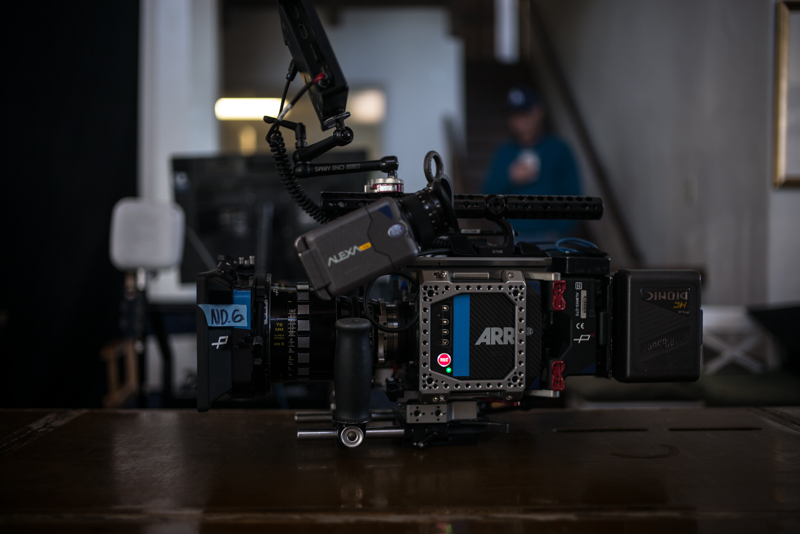
We shot this ad on two Panavised Arri Alexa Minis with a combination of Panavision Ultra Speeds and Super Speeds.
For lighting on this shoot day we had:
Absolutely nothing
We had a few 4x4 frames of diffusion and 2 12x12s of Blacks
Natural Light: The Set Ups
Shot #1 - In The Drink
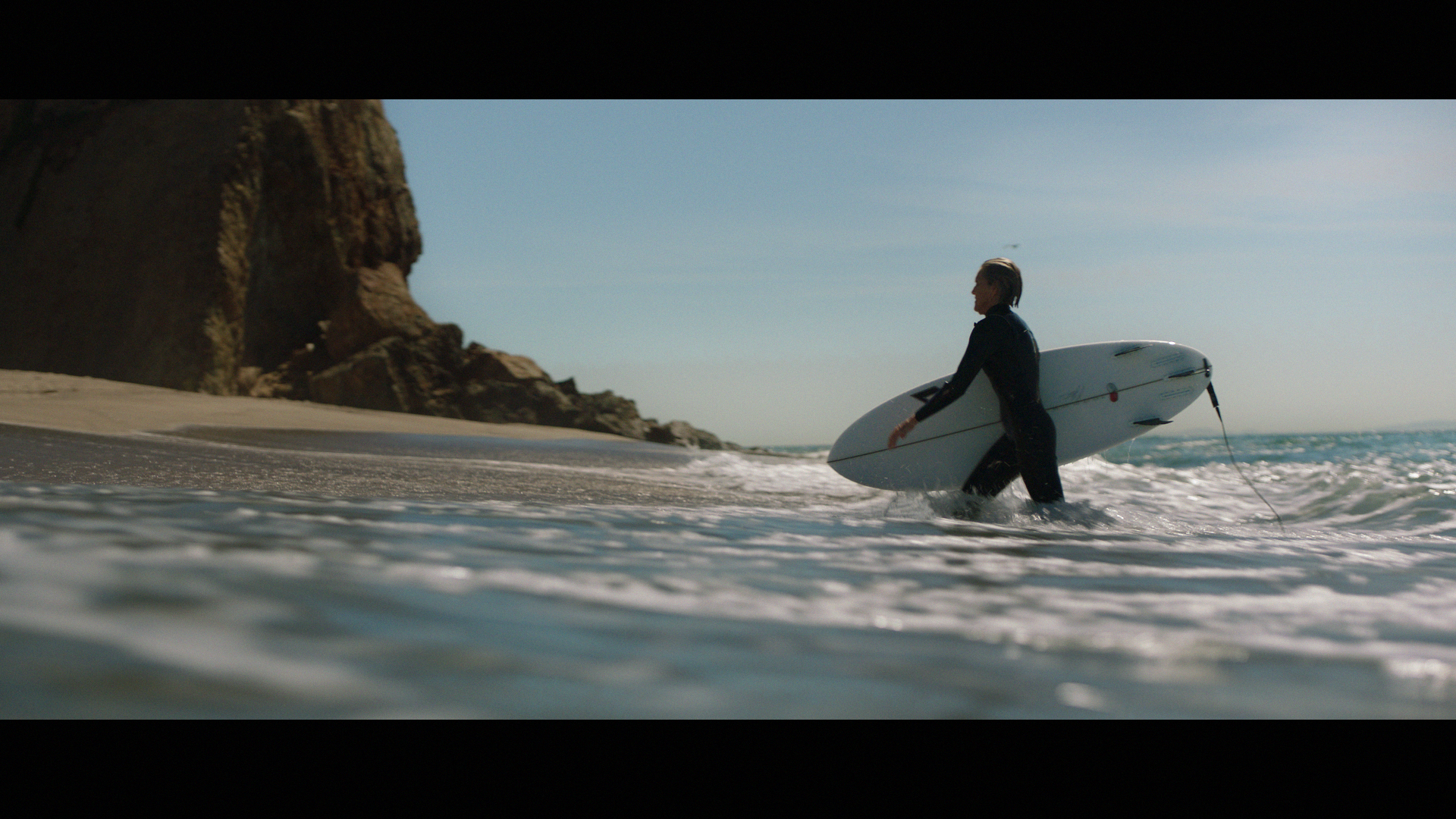
The Shot
Our opening shot shows our hero talent getting out of the surf and running on shore.
The Lighting
We didn't have a lighting team on the day so we were going to be using rags and bounces to get the job done.
In this shot we had a shiny board off the frame left and we let the sun and the angle of the action do the rest.
The Result
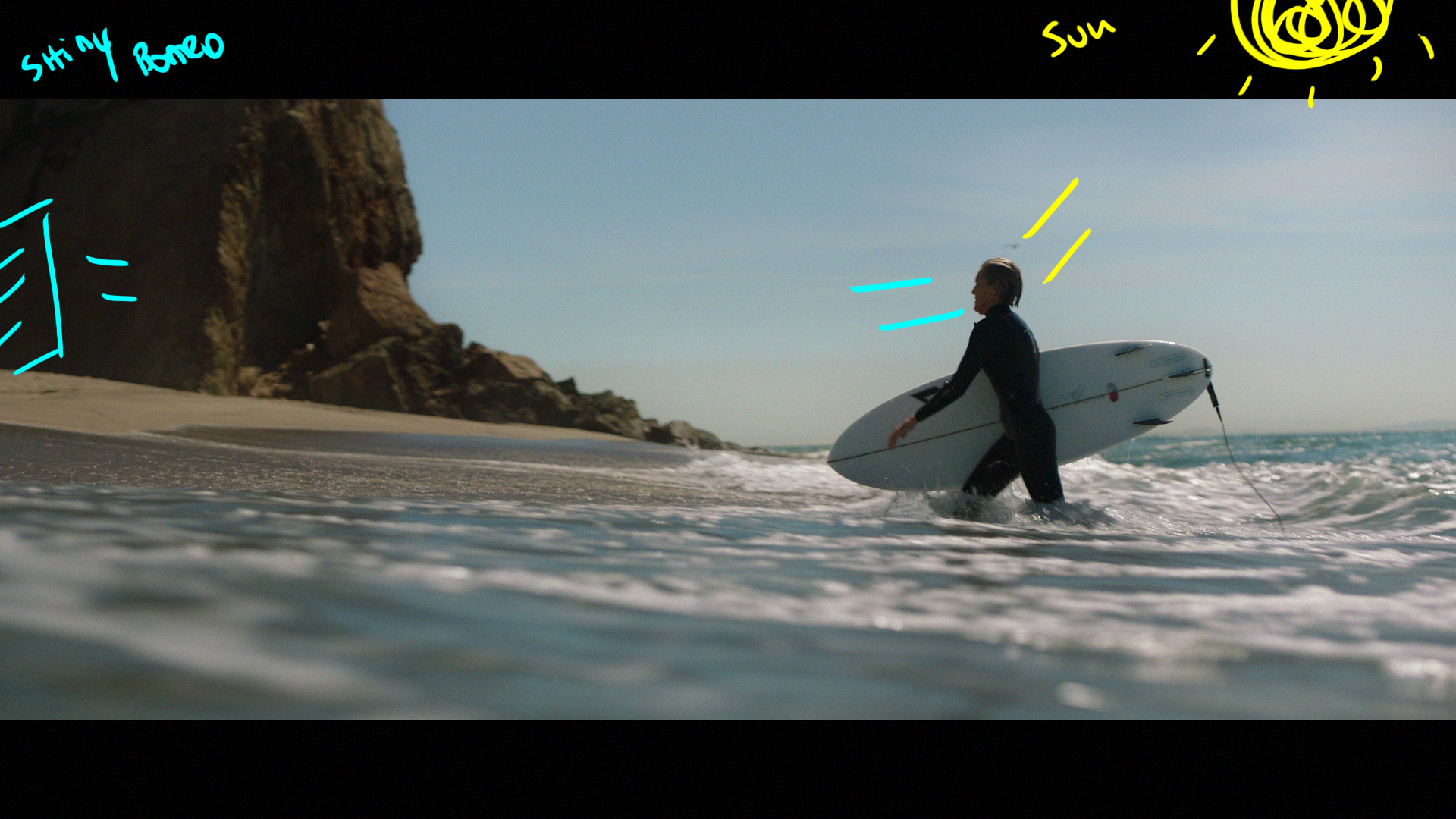
Behind the Scenes
Shot #2 - In the Pocket
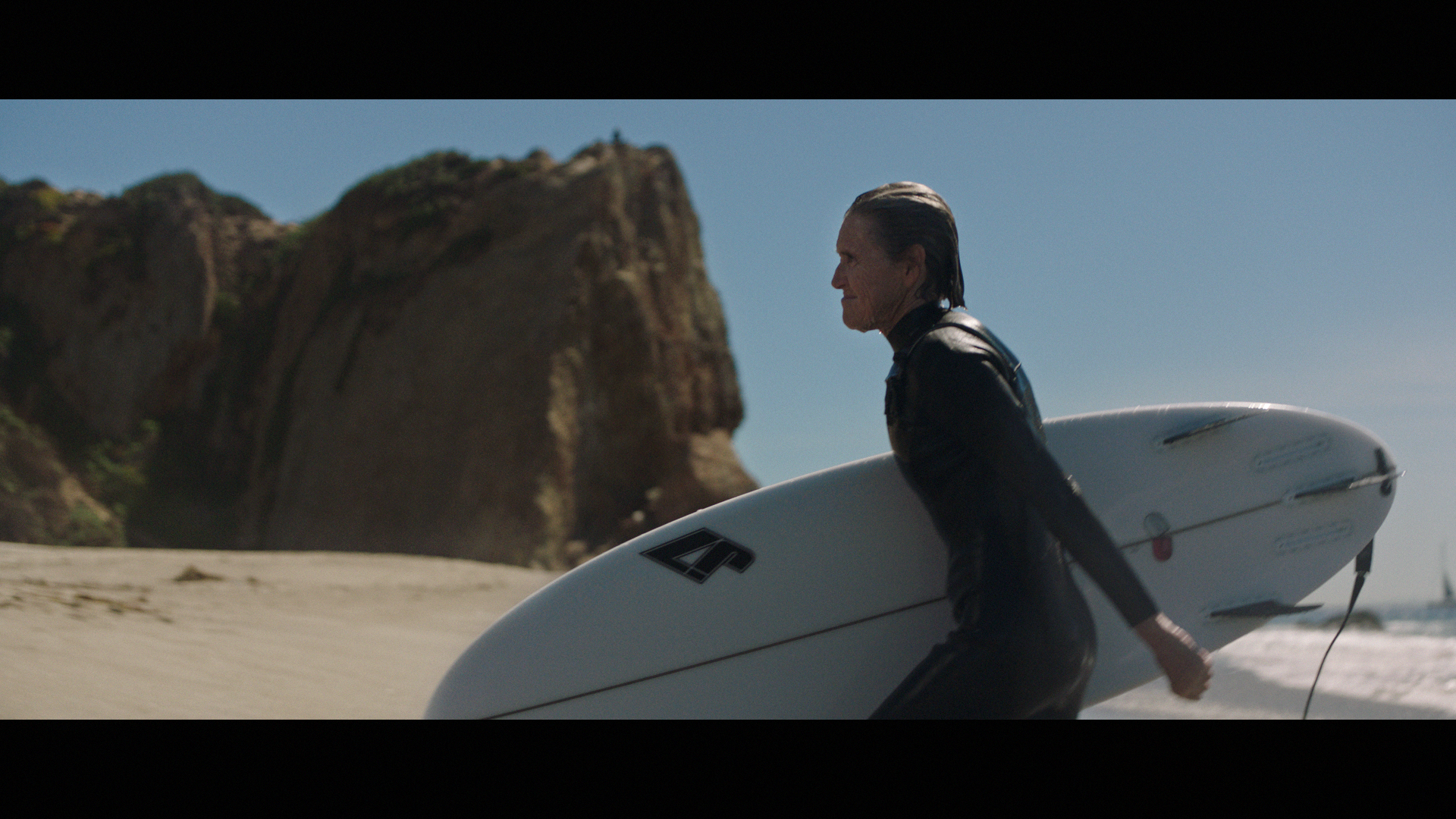
The Shot
This is the B cam shot of the same sequence. In tighter for the short grab.
The Lighting
The lighting here is identical to the previous frame but now you can see more of the effect of the shiny board as the talent makes their way closer to the source.
The Result
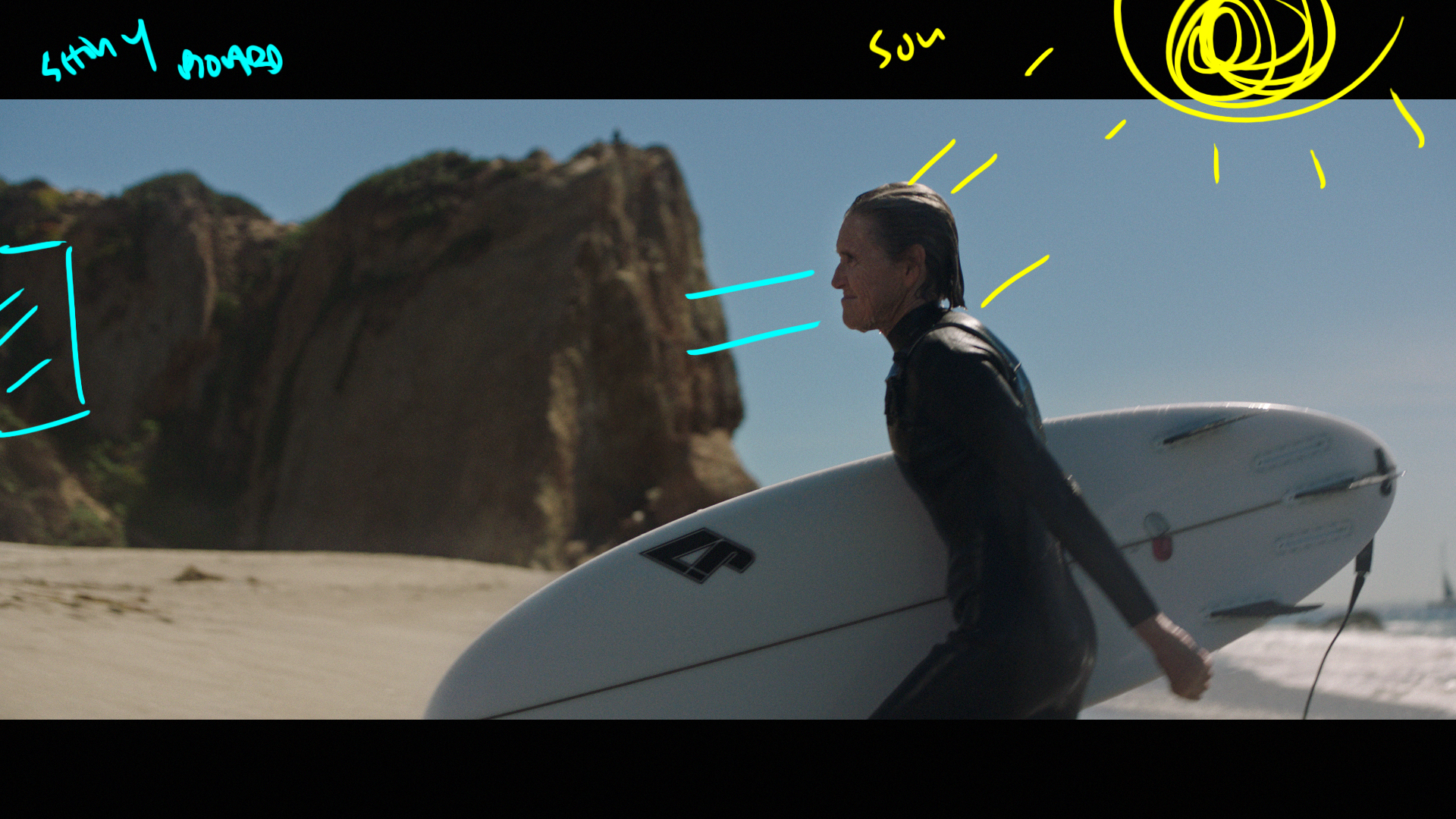
Shot #3 - The Wide Wave
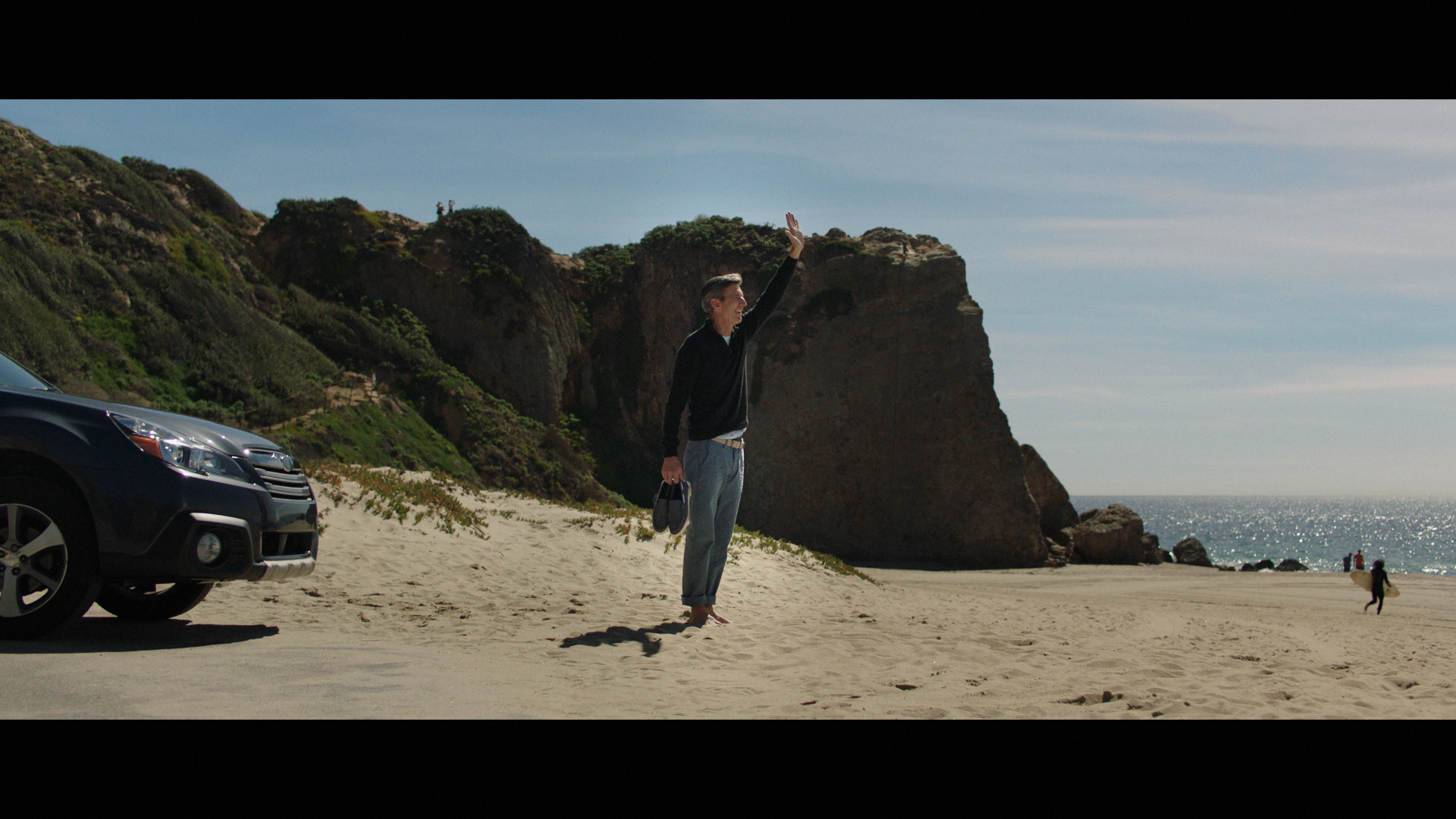
The Shot
We are up in the parking lot and we needed to see our spokesman waving the talent out of the water.
The Lighting
When shooting exteriors on a sunny day it all comes down to the camera angle and the blocking relative to the sun. The BG is down because the orientation of the location relative to the sun and that relationship is enough to give us some shape.
The Result
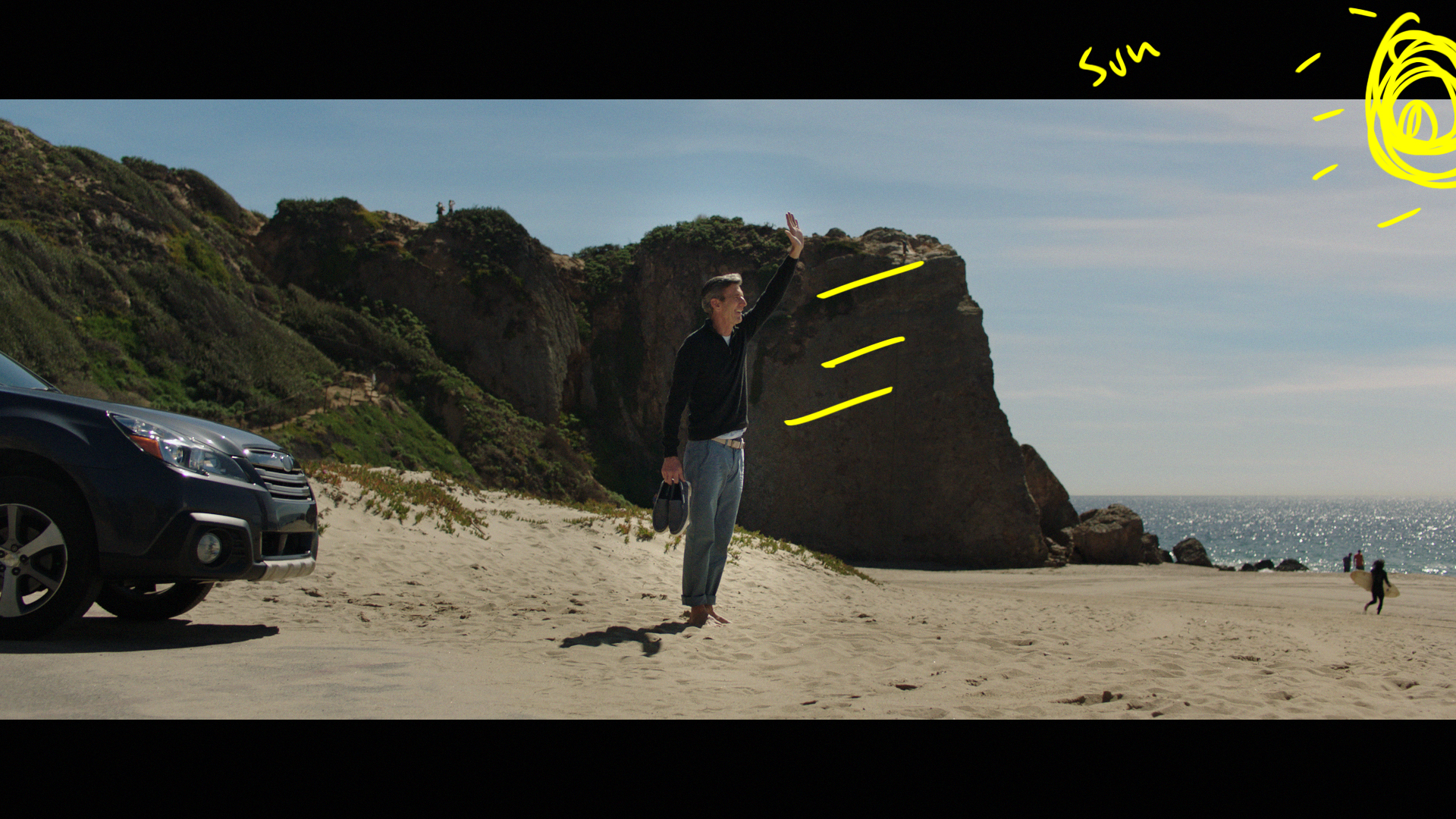
Behind the Scenes
Shot #4 - The Intro
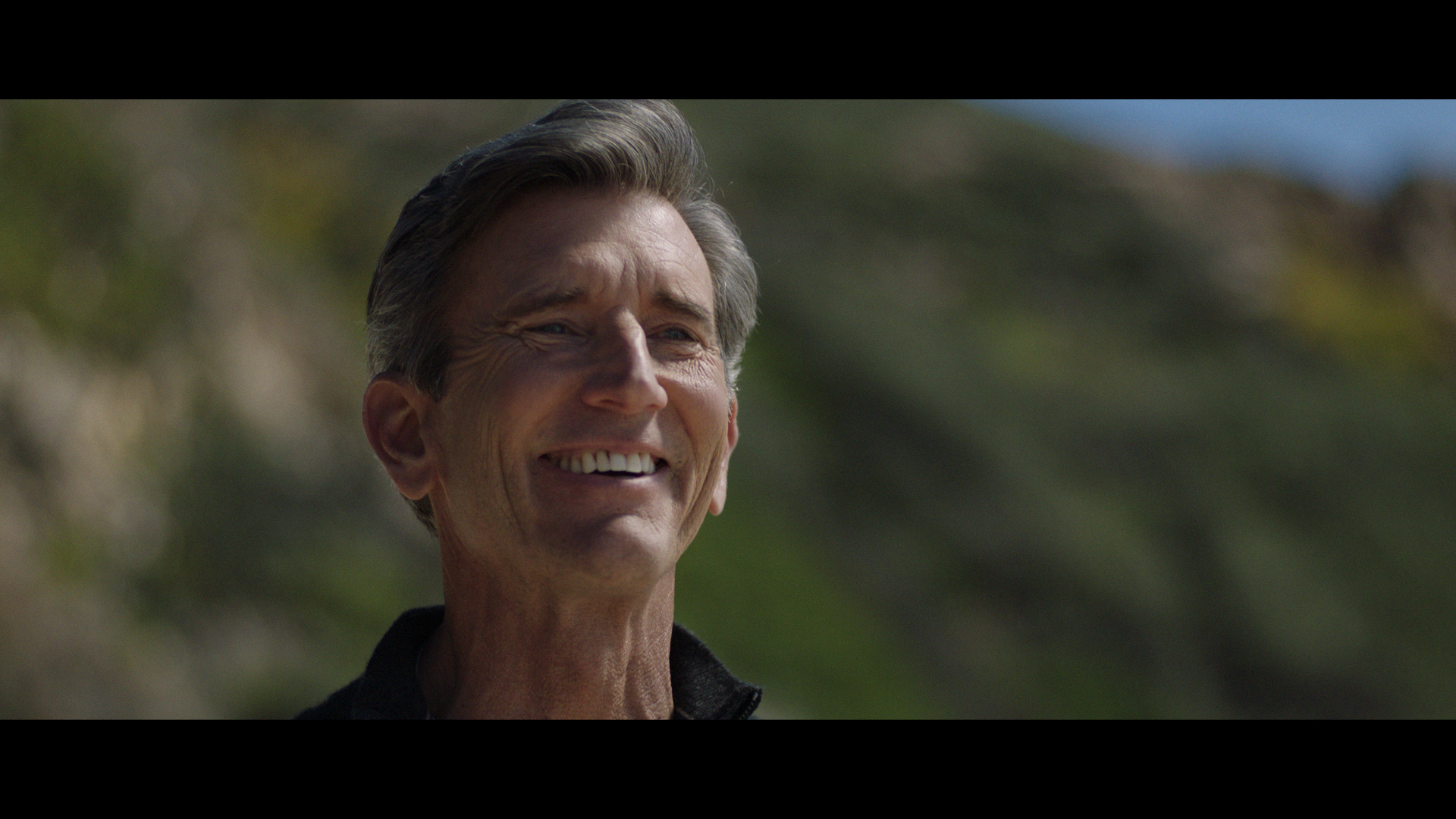
The Shot
We move in for our title shot and now we can use some smaller textiles to shape the light a little bit.
The Lighting
Overhead we had a 4x4 frame of Hi-lite and we didn't need a larger rag as our talent wasn't moving and we were fairly tight.
To take some of the ambient light away we used neg fill camera left.
The Result

Shot #5 - The Meet & Greet
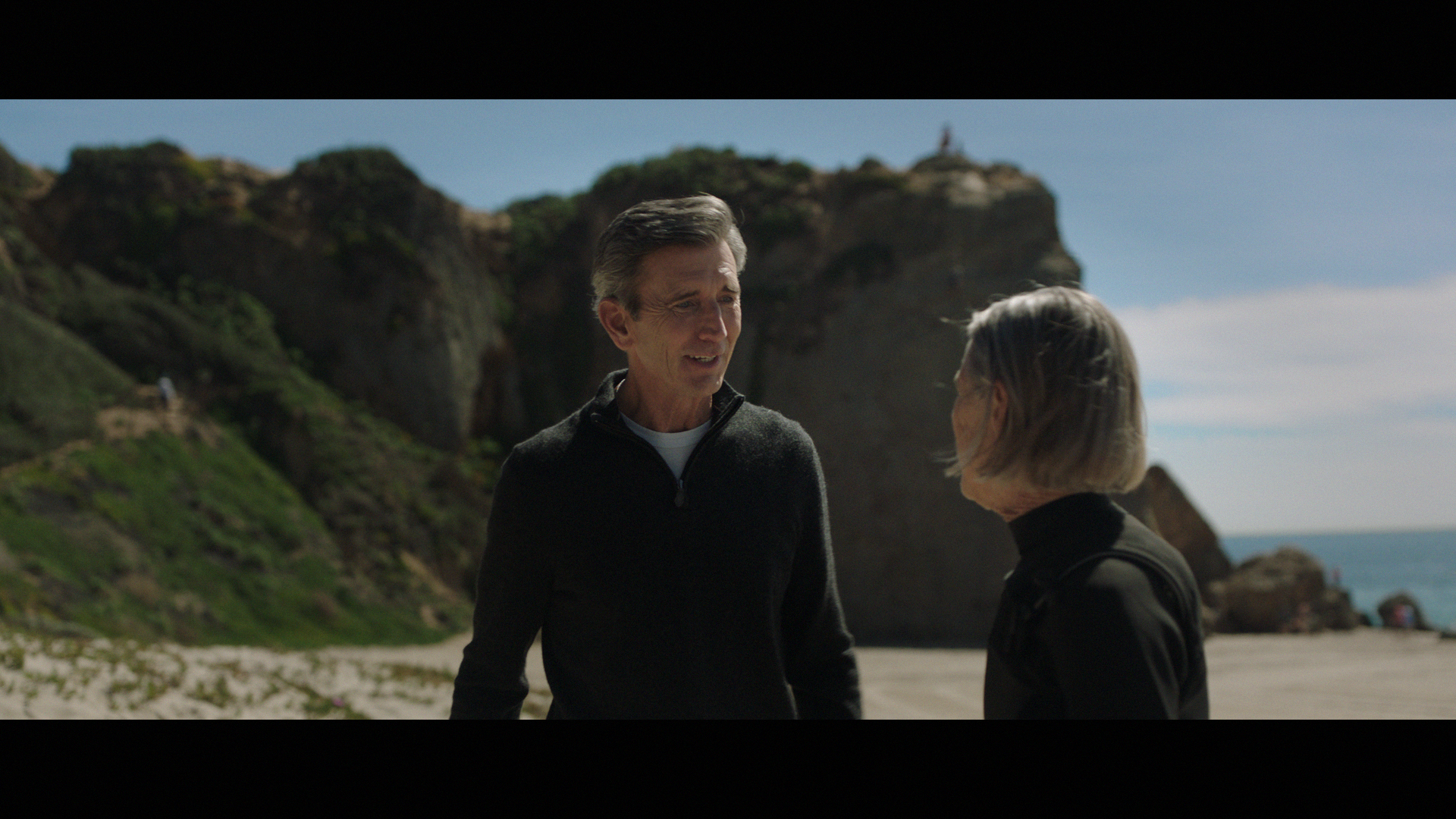
The Shot
These are our meet and greet moments. The talent say hello and shake hands.
The Lighting
The main thing we did to shape this shot was adding blacks to the ground to suck up the bouncing light off of the sand. The return light can flatten things off and make them feel washed out.
To hold the contrast we just laid some blacks down and then brought in the 12x12 negative fill cmaera left.
The Result
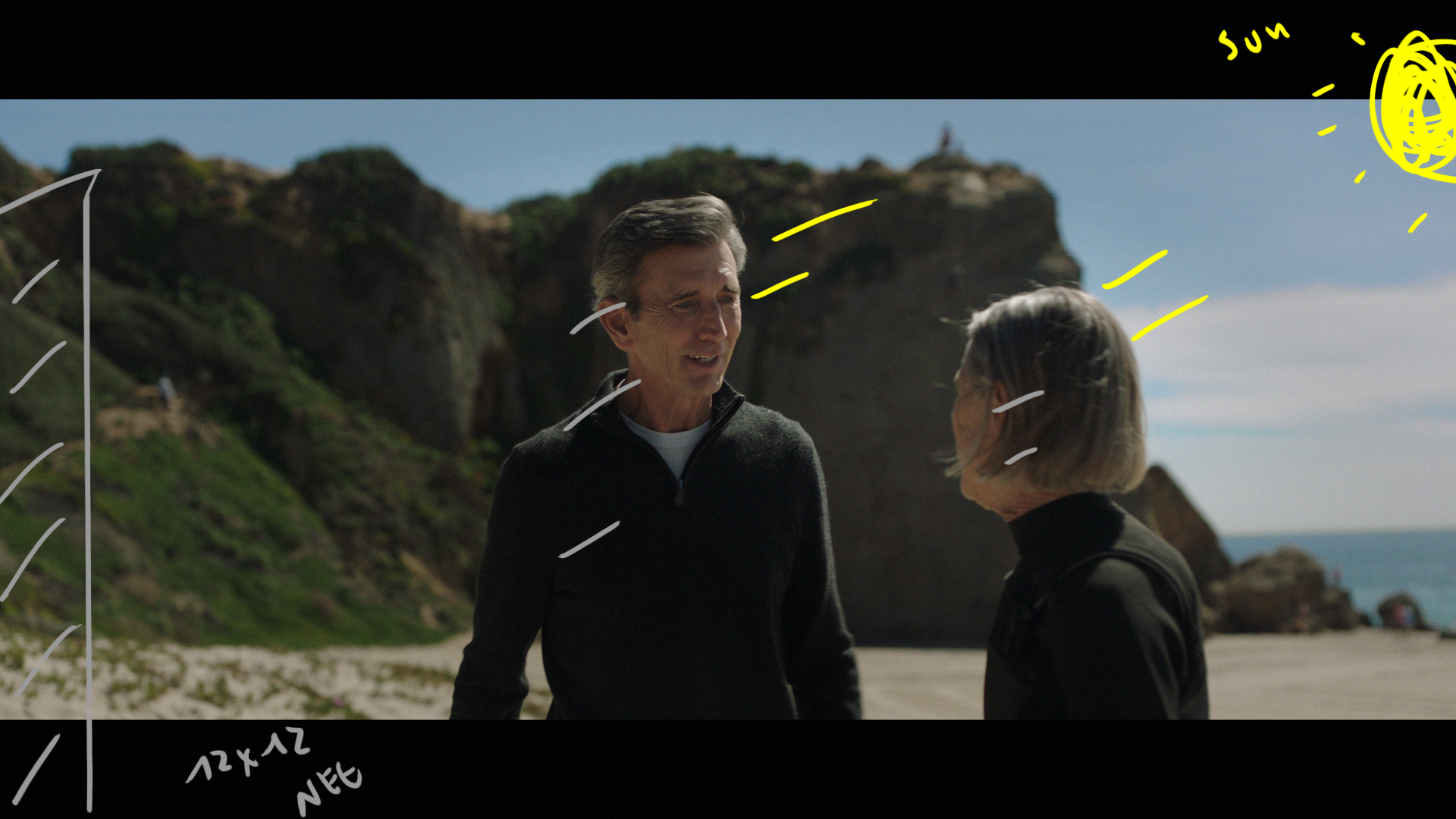
Shot #5 - In Tighter
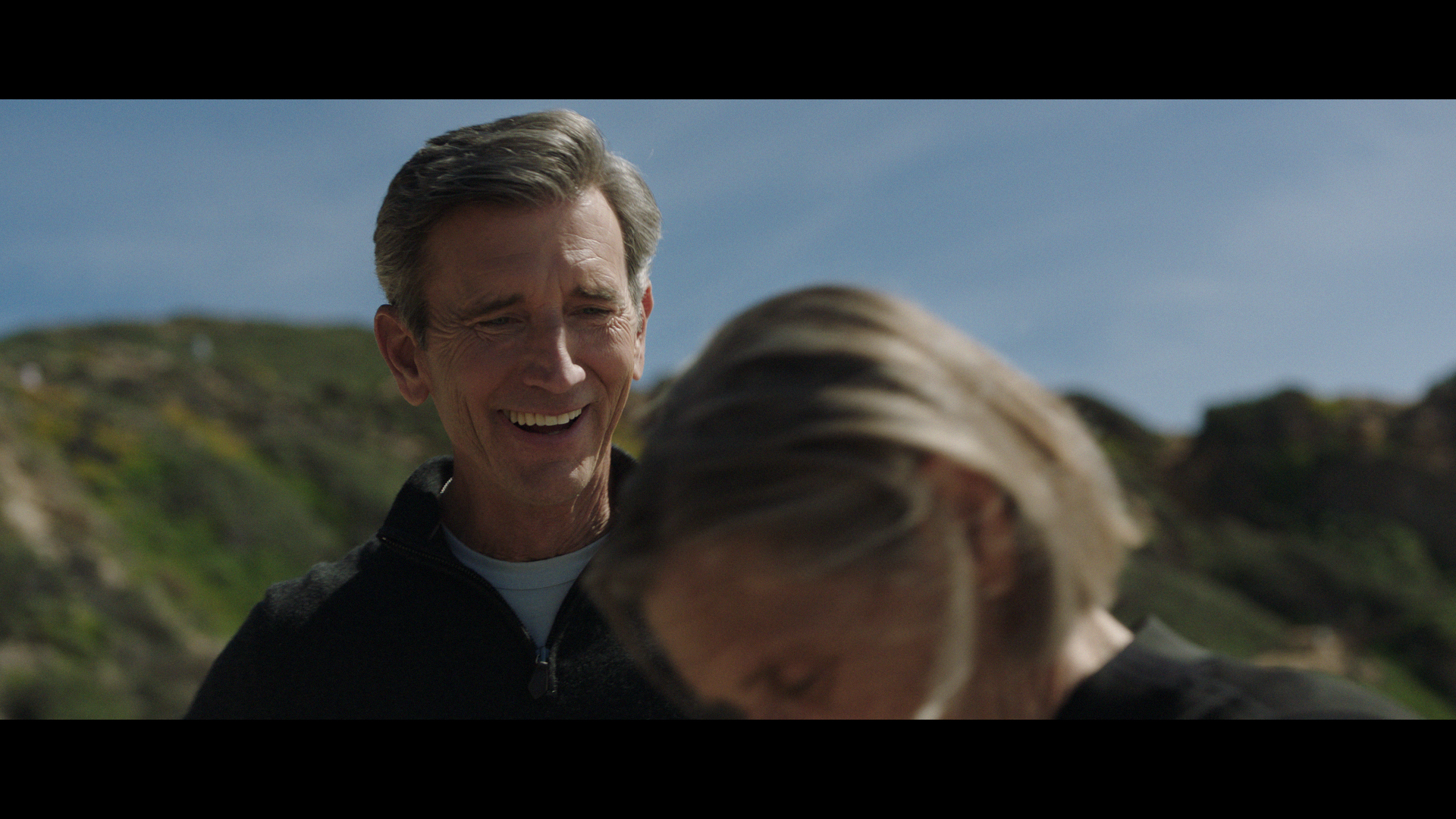
The Shot
This is the B camera shot of the same set up.
The Lighting
In this example you can see how the angle of the talent/camera relative to the sun in the background does all of the heavy lifting for us. You can still have the light to dark pattern even when shooting outside.
The Result
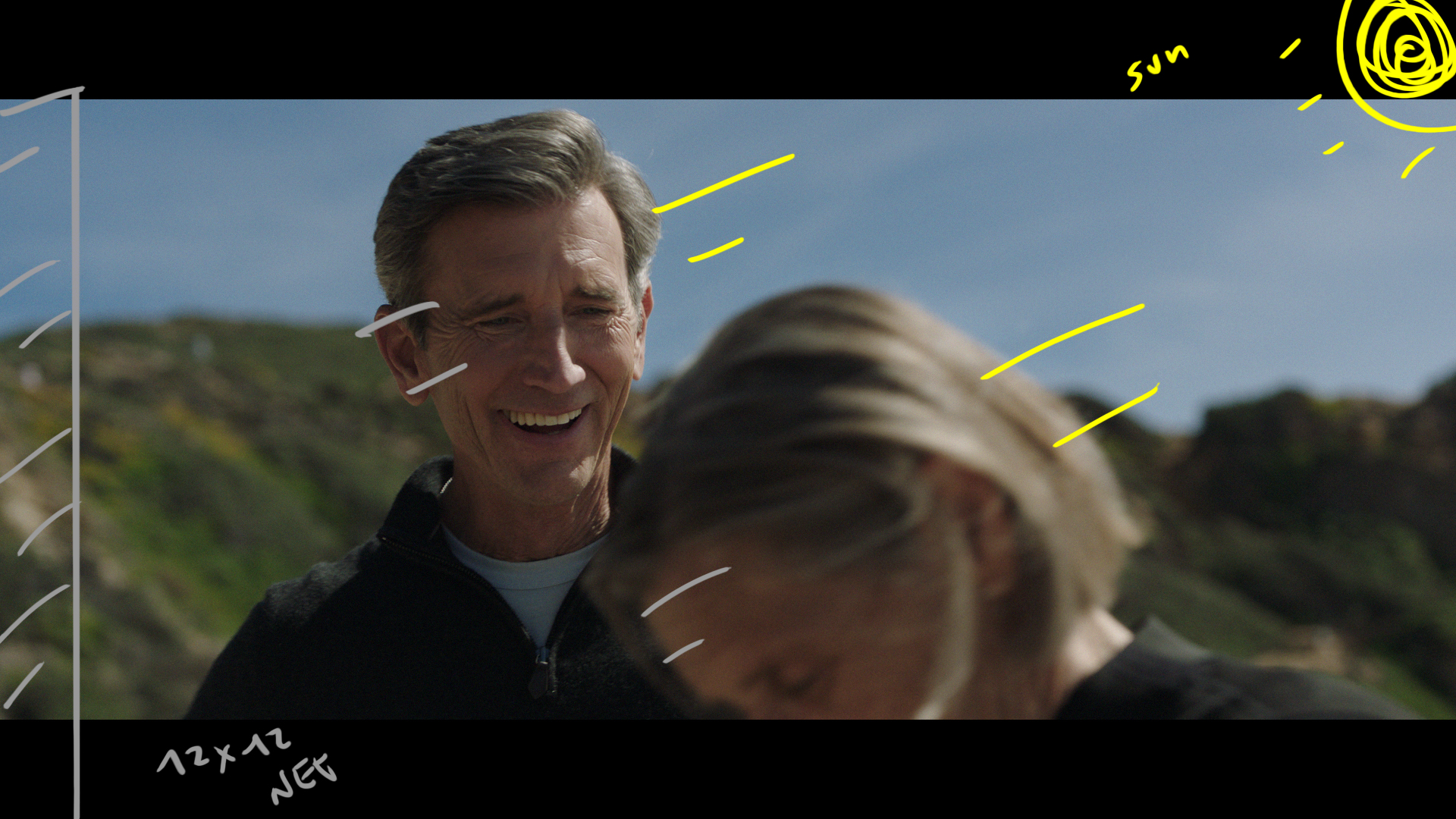
Shot #6 - The Car Shot
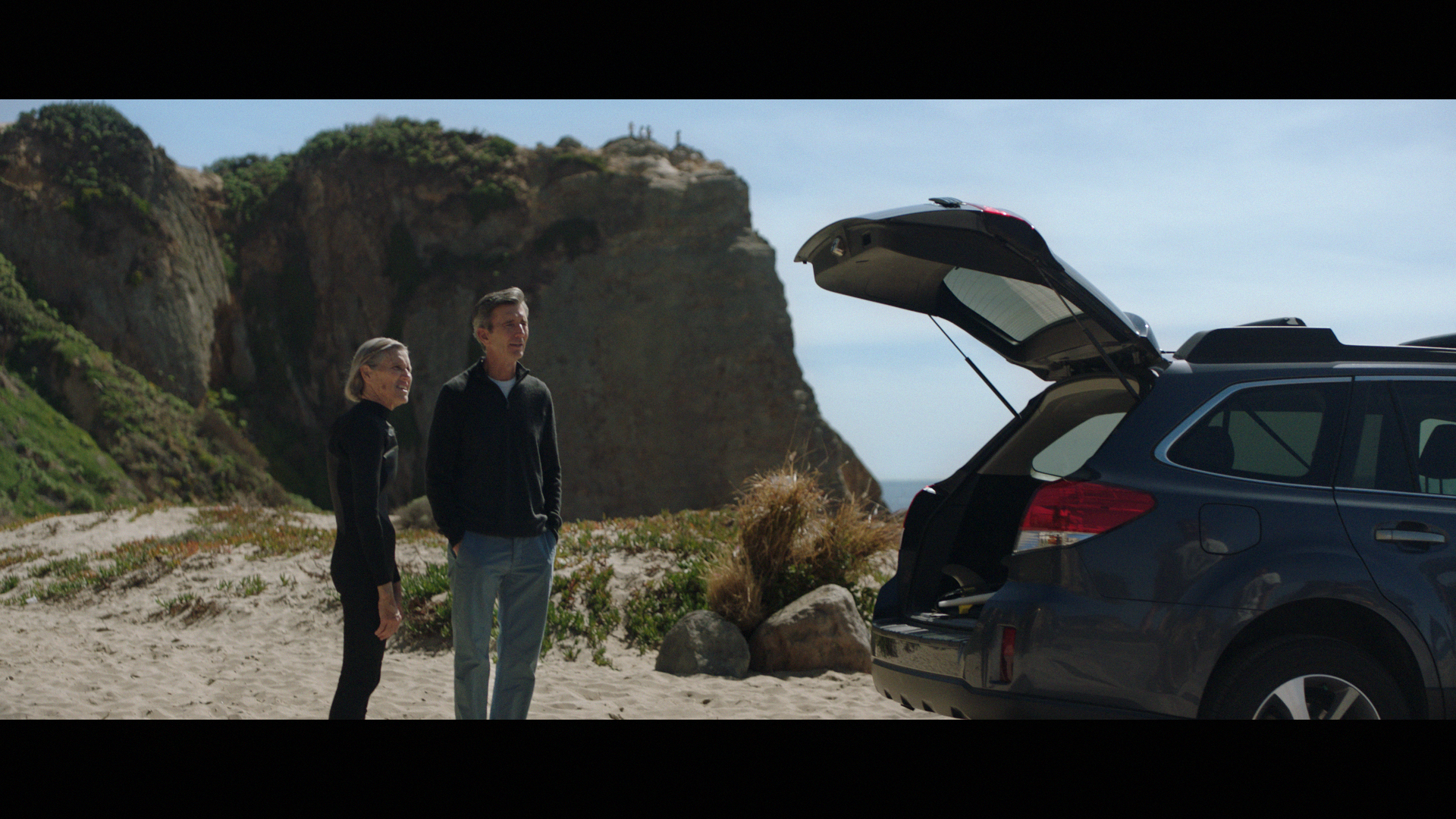
The Shot
For our wide shot in the parking lot we need to see the car and the talent walk off to the interview section.
The Lighting
The longer lens wide shot allows us to sneak in some neg fill on the ground and on camera left to help hold the contrast. Everything else about the shot is natural light.
The Result
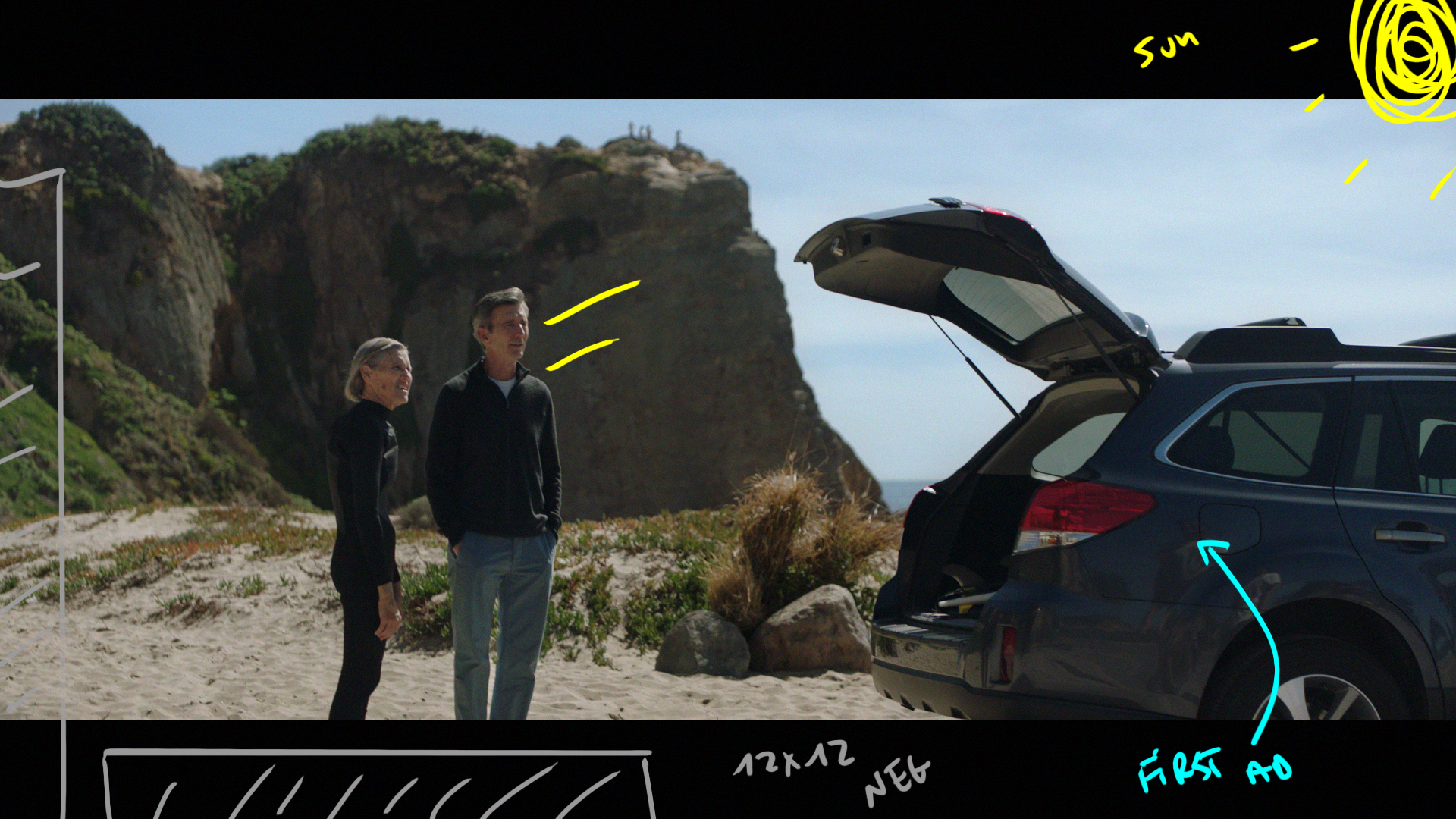
Behind the Scenes
Shot #7 - The Sit Down
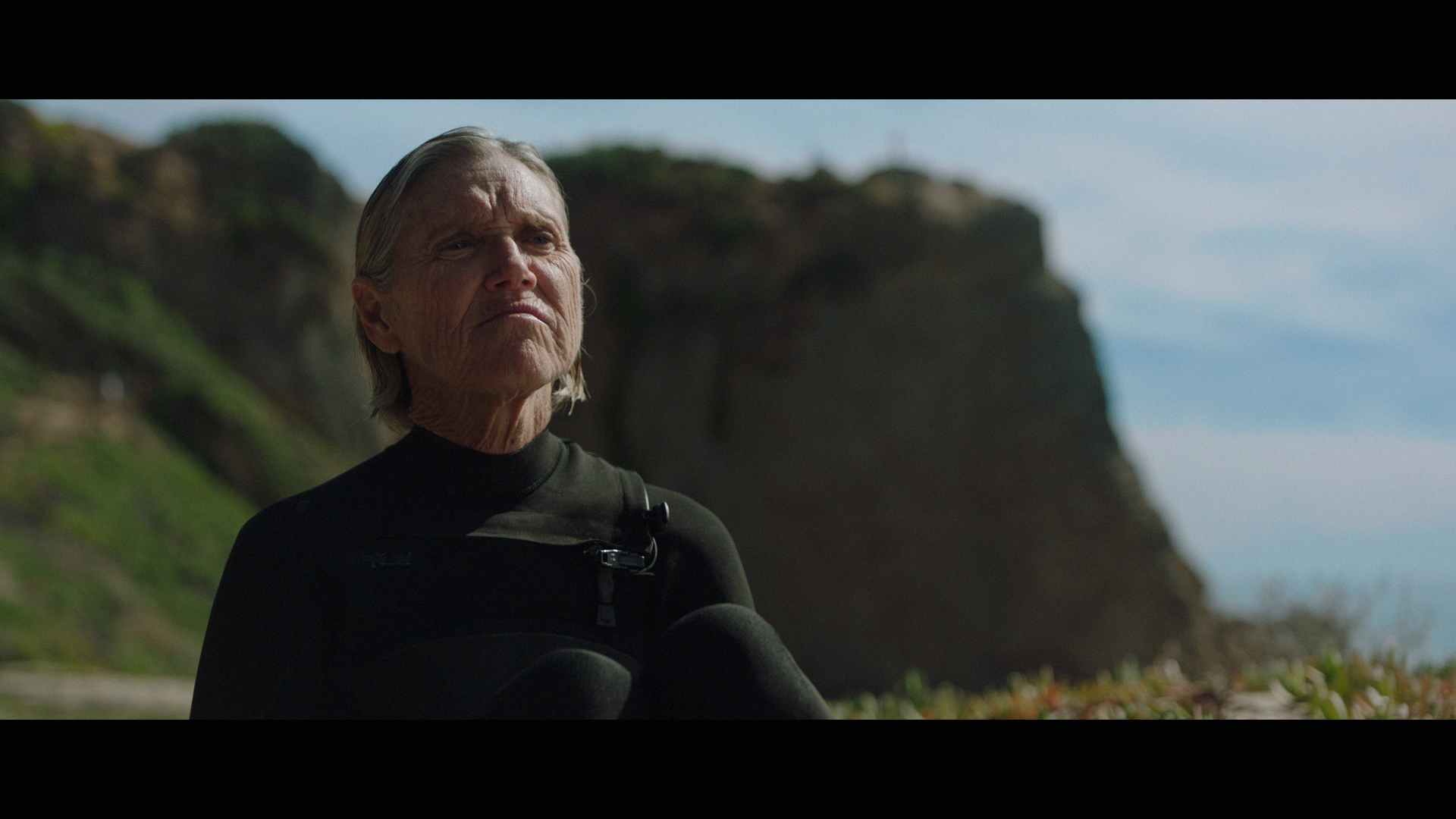
The Shot
Now we are into the conversation section featuring our two talent.
The Lighting
For this sequence we kept her single clean and used her position to get an angle that didn't require to much finessing in the lighting department. We embraced the harshness of the sun and added to the contrast with some 12x12 blacks on camera left to suck up the ambient return light.
The Result
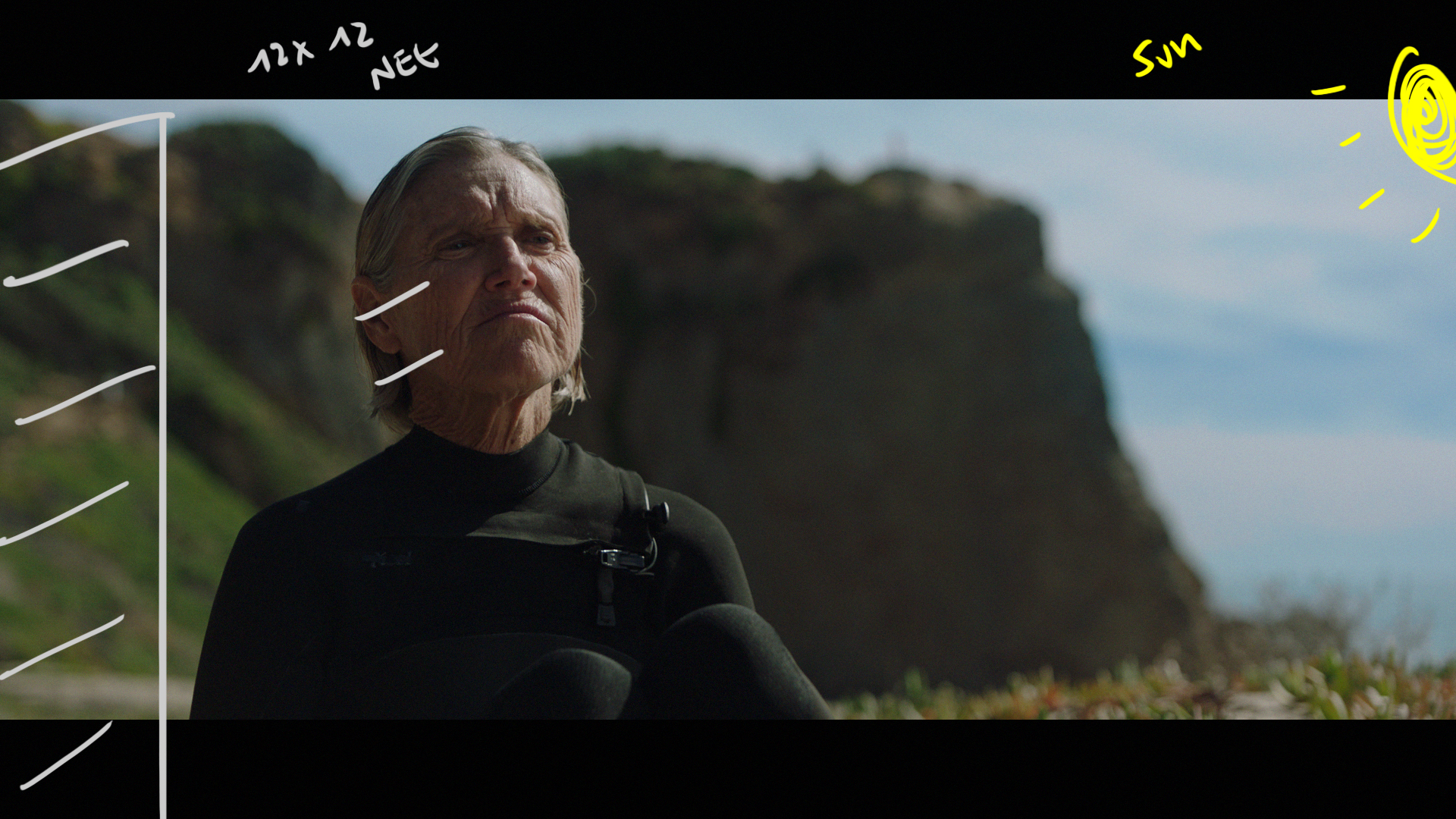
Behind the Scenes
Shot #7 - The Reverse
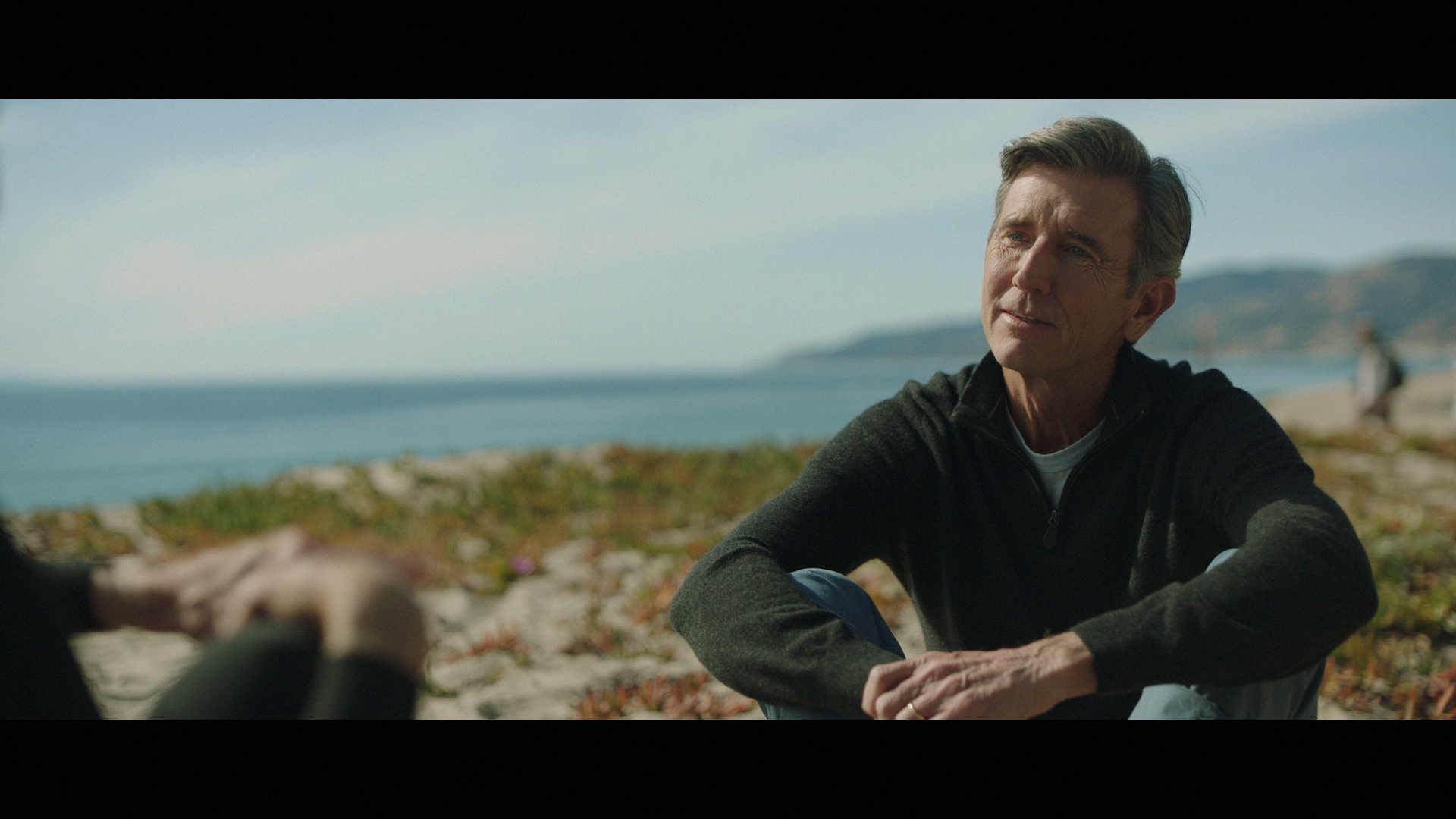
The Shot
The reverse angle of the previous shot.
The Lighting
Now we are looking in the opposite direction shooting from the other camera. You can see how the position of the action relative to the sun means we have mirrored images with the benefit of shooting into the shadow side of the talent to help maintain some interest.
The 12x12s camera right are playing just out of frame and they are helping to keep the draks dark.
The Result
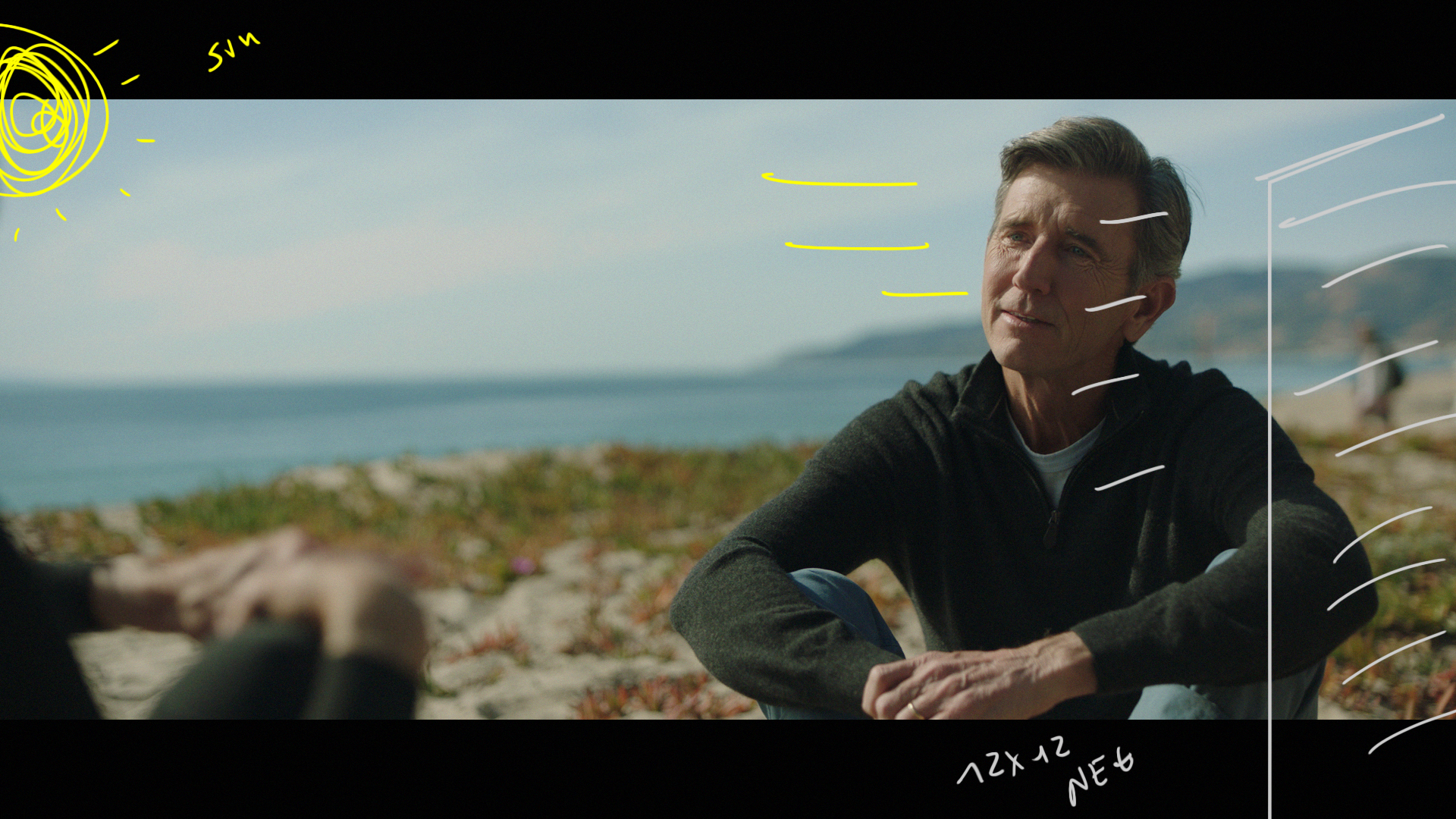
Show Transcript - Natural Light
Patrick:
Oh ladies and gentlemen, the first one, on video, you can see me. This is weird. I feel weird. Let's do it.
Announcer:
Welcome to the Wandering DP Podcast. Where we focus on Leica photography, cinematography, and life off set. And now you're host, Patrick O'Sullivan.
Patrick:
Ladies and gentlemen of the podcast world, welcome to episode 130 and yet again another zinger of a title. This one is Natural Light? I think I called it. Natural Light. And we are continuing this breakdown process.
Patrick:
00:35 Now I have to say, before we get started, if you're looking on the show notes page, wanderingdp.com/episode130 you'll notice something different right away, and that's that you can see me. There's a video portion of this podcast and why on earth you would wanna look at my mug when I'm talking into this microphone, that escapes me. But enough people have asked for it that I figured for some strange reason people are consuming their media on YouTube, you wanna sit and watch me flap my gums about the stuff that we're gonna be talking about today, here we go. I'm gonna give it to you. So that is different about the podcast, there is a video component to the show.
Patrick:
01:12 And this is the first one back from Los Angeles. Cine Gear has come and gone. The podcast did its entire move across the oceans to the distant lands of Hollywood, and we're back. And it was crazy. We recorded a shit load of podcasts. I think all up it was about 38 hours of talking about cinematography with directors and cinematographers and all sorts of craziness. And it was a whole lot of fun. Everything worked out as planned. I only accidentally erased one podcast and unfortunately for that person, it was a cinematographer, we're not gonna mention any names, but that was an hour of lives we'll both never get back. And I haven't told that person. And chances are I'm not going to tell that person. Hopefully it just fades away into the ether of the world. But that's the price you pay when you have someone like me backing up their own stuff, so, we only lost one.
Patrick:
02:07 So that means we have a ton of amazing interviews coming up. And it was really cool. It changed the entire dynamic of the show being face to face with people and the questions and the content was entirely different. And I think that you're gonna get a lot out of these episodes coming up, a lot out of the interviews coming up. And we've got a lot of great content. So I'm excited. So there's that.
Patrick:
02:27 With that, I think is gonna come some changes to the show because times are evolving, things are moving on. And the number one thing that I think is gonna change is because we have this backlog of interviews that I think you're gonna get a lot out of, we're gonna try and do more of the interviews on the podcast. Which means that the breakdown episodes, they may slowly but surely start to move over to the Patreon section. And that's because, I mentioned this on the Patreon episode last week, sometimes as the jobs progress and as the jobs get bigger and the budgets get bigger, people start to get a little bit touchy.
Patrick:
03:05 And when I say people I mean the agencies and the production companies. They start to get a little bit iffy with you putting out this sort of content where we're talking about this stuff. They really like to just come out with the commercial and never hear about it again and they don't want someone, like myself, some rogue dipshit I'll call myself, breaking things down and showing it to the masses how it all gets done. So as those projects happen more and more, at least on the Patreon side I can release them in a controlled environment where they're not getting out there to the great unwashed masses. So that will probably be happening more and more on Patreon.
Patrick:
03:38 That's not to say that the breakdown episodes are going away, they are not. We're just probably going to be doing more interviews because ... more interview episodes because we have them and because I'm excited about the content that's going to come out. And, you know, you learn some things when you do whatever it was, 38 hours of podcasting in a week.
Patrick:
03:56 Number one, I say a lot of stupid shit.
Patrick:
03:59 Number two, the difference between, because we had directors and cinematographers in, the difference between a director and a cinematographer, the chasm that separates those two is enormous, right? And you don't really think about it when you're starting out, or even when you're on a job. Job to job basis if you're cinematographer. Very rarely are you on a another job with another cinematographer. They'll be some rare times where that may happen, where you're overlapping or you're shooting something together, I don't know. Sometimes that will happen. But very rarely do you come in contact with people who are in your same profession. Same for directors.
Patrick:
04:31 And I noticed some patterns that I thought was interesting. Number one, this is the big one, is it is really difficult, and I don't think we had a single case of it and this is not me kissing ass here, the directors that we had on the show, it was really hard to be a successful director and be a dipshit. All right, you've gotta be pretty switched on. There's so many people throwing little bombs at you all the time, little mine fields that you're navigating all of the time, that you have to be pretty sharp. And you have to be pretty savvy.
Patrick:
05:02 And you can hear as I'm building up to this that the opposite side of that is as cinematographers ... What's the word that I'm looking for the type of person? You can be a bit of a space cadet. That's not to say that we had space cadets on the show, in fact we had nothing but the finest guests on the show. But you can be a little bit more ... How can I say this kindly? You can be, I don't know, a little bit more out there if you're a cinematographer. And I noticed that straight away. Because on Skype sometimes, you know, it's difficult to gauge personalities and it's difficult to gauge the way someone interacts with human beings because there is that barrier of Skype. But now face to face with these people, who are all very open and very forthcoming and shared a lot of great stuff and everybody had their own unique stories and I'm sure you're gonna hear all it, but there was nowhere to hide. And personalities came out and differences came out. I think that was the big that I noticed is that you can be, I mean anybody can be a cinematographer. Any personality type, any strengths, any weaknesses, any smarts, any not so smarts. They're all in that realm, there is no path to success or anything like that.
Patrick:
06:14 But directors, if you are out there and you wanna be a commercial director, from what I've seen, the people that we talked to, you have to be pretty switched on, pretty savvy and ... intelligent, I guess is the word, if you're gonna be a successful director. Commercial, non commercial. There's just so many obstacles, there's so many things you have to think about and juggle in your head that you gotta be pretty switched on. So I thought that was pretty much the most interesting thing taking away from all of these interviews that we had done in person.
Patrick:
06:40 Now, the trade show, Cine Gear, happened. And I didn't get a whole lot of time. I thought I was gonna get a lot more time to walk around and hang out and see all the different stuff. But I realized quickly, as soon as I got there, and I think I realize this every time I go to these events, that I absolutely hate walking around amongst the unwashed masses and looking at gear that I'll probably never use. Right? I use a very select number of items. Most of the stuff never even sees the light of day for myself and my projects. Not to say that they are unimportant because I don't use them, but just because you sort of have your set go to list.
Patrick:
07:20 And there was only one item that really, that I said to myself, "Okay, if this was available for purchase, I would get it for my next project. Or if I could rent this I would get it for my next project." And I think that was, it really was the thing on everybody's talking points for the entire show, was the Panavision liquid crystal use the voltage to change the ND filter that is a drop in tray. And that thing is cool. If you haven't seen it I'm sure if you google Panavision filter it'll come up. But that was really the one thing that I saw was like holy shit, like that is really smart and someone is gonna rip that off and I'll be able to buy that in six months. Or I'll be able to use it, the rental house will have it. It was really, really smart and you can ... You know, it's those few minutes on set when you're trying to change things that that's the bit that you wanna try and get rid of because that can kill a vibe. So anytime. But then again you have to ask yourself, by the time someone copies that and copies it 10 times over and next Cine Gear there's gonna be 15 different versions of that, how long before they just put it in the camera?
Patrick:
08:19 Speaking of which, up comes the Sony VENICE. It was everywhere because Sony sponsored the show. It's very cool. Everybody I talked to that had used the camera on a production said there was ... You know there was ... It had it's issues as a camera, but not to say it wasn't fixable, but it was everywhere on the show and it looked cool. Cool enough to change directions? Not sure. But it was pretty cool. Yeah, that's pretty much all you can say about it.
Patrick:
08:44 The other cameras and all of that stuff, again, I briefly made the tour around, but the cool part about going to the trade shows is that you get to see all the people that you've worked with. You get familiar faces, whether it's from manufacturers or from rental houses or from crew, first ACs and steady cam people, operators that you see, that is cool because you get a chance to chit chat. And it was a lot of fun this year to see everybody from the Patreon group come up and say hello, even people not from the Patreon group, just listeners of the podcast, to come up and say hello. Because that makes it real. You know there's actually people out there listening. I start to get freaked out that people are able to come up and say hello, but then again it's cool because everyone has their own story. They've all gone their own ways of listening to the show. They all have got their own interpretations of which, not that I make jokes, but which things are funny or which things that catch on to and I think that's, it just made it a little bit more real.
Patrick:
09:35 So thank you if you came up at Cine Gear and you said hello. If you listen to the show, thank you. Because it's fun to do and it's fun to sit here in my closet, as you can see here now finally, you can see it on video, you can see I'm sitting here all by myself talking to myself and it makes it so much more real and tangible when you can get out there in the world and see exactly who's listening. So that was a lot of fun. So thanks to everybody that came out and said hello and even to the Meetup, we had a couple drinks one night at the local and a lot of people came out and said hello and we got to meet and greet and look at some different cameras and have a chit chat and hear all about the projects you guys are doing. So that was cool.
Patrick:
10:14 Now, I mentioned earlier changes to the podcast in the sense that we're probably going to be doing more interviews, right, because we've got those and people are drawn to hearing other people's stories about, not only how they came up, but the ways that they're working now. And we talked to a ton of different people. We talked to, you know ... Who am I? I'm blanking on people. But basically everyone from doing huge television series of shooting for 150 days versus people doing fashion films or fashion TVCs for a day. And all, the whole gambit from directors to cinematographers to people on big stuff to people who have been doing it for 50 years to people who've been doing it for 5 years.
Patrick:
10:52 We talked to [Denny Linwar 00:10:54] one day, ASC, just the nicest guy ever. Just like he is in that documentary that cinematography documentary online which I have no idea what is, but I'll put it in the show notes page. He's just that nice and he's still that enthusiastic about cinematography and he invited us to the ASC clubhouse, and we got to go and hang out and meet and greet with all the people. And that was fun. But, yeah, I don't know. I don't know why I even brought that up. I just thought in my head that was one of the memories that I had from the trip and it was really good. Los Angeles is cool.
Patrick:
11:27 The other change to the podcast is because it was really nice to interact with people and see them face to face and hear their problems or hear their questions in person, I thought why not bring that to the podcast? So what we've done on the show notes page wanderingdp.com/episode130 now there's a little hotline. And that hotline you can call up, all you do is hit the button, you can record a 90 second message, you send it through to me and I'm gonna go through each week and I'm gonna pick questions or comments. It can be, you know, I don't know, you can tell me I'm a bag of shit, you can tell me that you liked the last episode. You can tell me where you're listening from. You can tell me if you've got questions about certain projects or if you've got questions about the industry or the way it works. Or anything like that, you just get on the hotline, send them through, and then each week we're gonna pick a few of those questions and we're gonna have them on the podcast.
Patrick:
12:14 And hopefully it just ... it makes it a little bit more real, a little bit more tangible and gets the listeners involved. Gets you involved. If you've got a question, you wanna hear yourself on the podcast, that's it. You hit the hotline and away we go. So that is the major change besides the changing of the structure.
Patrick:
12:32 So, like I said over on Patreon this week we are finally back on the livestream. I know it's been awhile. I know I said it last week and we had to come up with a podcast, but now we are back on the livestream, so again if you've got questions there we're gonna be asking to review projects. So if you've got some stuff that you've shot that I know talking to a lot of people at Cine Gear talking to a lot of people at the Meetups, everybody's got projects that are coming through. You're starting to see results. And you can send those through and we're gonna look at those during the livestream over on Patreon. So I think that's that it.
Patrick:
13:02 I think that's it, except, we forget our friends, ladies and gents. Oh you know who it is, the Musicbed ... Musicbed is making better music accessible to everyone, from your wedding films and small businesses to broadcasts, ads and feature films. With their highly curated roster of over 650 artists and composers, 650, they've developed soundtrack, they've helped soundtrack ground breaking projects from Jaguar, Apple, Hulu, Nike as well as HBO's The Leftovers, Amazon's Transparent, and Oscar winning shorts.
Patrick:
13:36 And now they are upping their game. With a completely revamped platform with brand new features, work flows and check out process ... You want to basically, you wanna include or exclude stuff, you want beats per minute, song build, you wanna search that way? You wanna find the perfect song? Well it's never been easier or faster because now you have all those search features that you can immediately bump into and get exactly what you are looking for. I've used the website myself. I've used the filters to find exactly the song that I was looking for, I was able to do it. And I'm a dipshit, so if I can do it, chances are that you can do it. And that's self diagnosed. So you can learn more at musicbed.com/new and you get 20% off your next onsite license with the coupon code Wandering20. Wandering20.
Patrick:
14:22 Now, our good friends Keslow, Keslow oh, not sponsoring the podcast. Ladies and gentlemen, a moment of silence for the Keslow sponsorship that ... just gone. Just gone just like that. I'll tell you what though, they're not sponsoring this podcast, but I did get a chance when I was in Los Angeles to go to their facility. Holy shit. If I was a first AC, I would be living at that facility. It is like the, it's like the Apple Store of rental companies. You know when you ... When I imagine rental houses, I imagine some dingy, shitty little warehouse with one guy who's, you know, half asleep, and you gotta go in there, you source your own gear. It's all in old shitty boxes and you gotta bring it out and you find their little prep area. And there's like cigarette smoke that's just lining the top of the building, it smells a little bit, just a hint of ass in the corners, and you can't quite put your finger on it, but it's there. And you open up the cases and it's all scratched and gear's all shitty.
Patrick:
15:21 Keslow fucking hell. This place is ... They got iPads at every check out ... First of all, there's about 20 different prep areas. There's just fucking prep areas everywhere. And everyone has showered. That's number one. That's a good thing. All the people that work there look clean. They're nice. They're smiling. They're happy. There's fucking windows, it's not some dingy cellar. And at every single prep bay, they got this little iPad. You can be ordering up lattes. You want a little cappuccino when you're doing your lens test? When you're putting on the anamorphics? You want a Americano? Just fucking hit the iPad. It was pretty cool. And they've got tons and tons of shit they've got ... I met their research and development team, where they're just coming up, cooking up mad scientist like shit all day long.
Patrick:
16:04 And I know, again, they're not sponsoring the podcast this time, but it is really cool and I suggest you go check it out. Just for your own sanity so that you know when you go back to your shitty little rental place, you can be disappointed. So, do that. And see where the bar is set. And then, you know, you can go back to your thing and just be sad. Just be sad forever.
Patrick:
16:27 Okay, anyway, that brought down the podcast to a different level than I wanted it to be, but let's move forward. Because this is a breakdown episode. And, oh you think you're gonna get tired of this series of commercials, do you? Well we've got this breakdown and then probably one more, I probably won't do it back to back though because we have seen these people's mugs quite a bit on the podcast recently. And if you're not familiar, if you are a brand new listener to the show, we've been breaking down this particular series of commercials for the last three or four episodes.
Patrick:
16:58 And this one is no different. We shot two cameras. We shot on the Panavised Alexa Minis. We shot with a mix of the Ultra Speeds and Super Speeds. And yes, that was a giant problem because of the color matching. We've already gone over that so I won't spend too much time. But basically for a brief recap, what we're looking at is there is a spokesman. And this spokesman goes around to different areas, finds customers and he wants to talk to his real life customers about their experience with the product.
Patrick:
17:25 So nothing, in terms of creative, nothing hugely groundbreaking. But we got to make it look nice. And we're gonna be in all these different environments. So far we've been in a river. We've been in a big warehouse or a big community hall. We've been in, where else did we go? We went to the house, to the back of the house. We did that one today. We are at the beach, right. And this is one where we shot it all in Los Angeles and this one happened to be in Malibu. Many of you who live there or who have been there will be familiar with this backdrop. It's some famous beach that I can't remember the name of. But it's out in Malibu somewhere.
Patrick:
17:59 The thing about this location was, the time of year that we're there and the orientation of this location, meant that we were never really going to be perfectly backlit. So that dictated the entire schedule because we then had to find an opportunity to shoot some stuff that was going to match the interview. And we wanted the interview to look as good as possibly because that was gonna take up most, the majority of the screen time for the actual spot. So when speaking with the director, Seth Epstein, we decided, okay listen we can get the most bang for our buck if we start a little bit later. So rather than go for that, you know, a lot of the times when you're looking for backlit beauty shot look, you'll look from sunrise until about 10:00. And then you'll break in between. You'll come back and shoot 3:00 until the sun goes down sort of thing.
Patrick:
18:41 For this one, it wasn't really going to work because of the sun path and the orientation of the location meant that we could have a little bit of a later start. The sun could come up behind these hills if you're looking at the show notes page, this very first shot of the woman exiting the water. We needed the sun to clear that big rock and then we would have something backlit that we could maintain and match for the rest of the day. Because that's really it. We're shooting all day. We're shooting over the course of whatever it is, nine hours. And we need to make it look consistent like it's all happening within a very brief window. And that is always the challenge here. So we're gonna get into exactly how we did that.
Patrick:
19:15 But we're on the beach. We are shooting a little bit later than normal and we are trying to orient the action so that we are at least get some shape, right? Because it's an ad for a product that isn't, we're not trying to go super dark or super moody, we're at the beach, it's sun. It should look like beach and sun. So we didn't want to go crazy, but we wanted to give it some shape anyway. So we're gonna talk about how we do all that stuff.
Patrick:
19:40 But the idea here is we didn't have any electrics. We had no gaffer. We had no truck. We had nothing on this day. So it was all gonna be done with grip stuff. It was all gonna be done with modifiers. We had some big instruments out and if you would look ... If you were to twirl the camera around 180 degrees from where ever these are pointing, you will see a shit load of people on this beach. And it is trying to navigate in those, amongst all the people and still be able to be flexible and to be able to find shots on the day. And I think we did a pretty good job of keeping on schedule and getting the stuff that we needed. And also trying to make it look as good as possible.
Patrick:
20:16 Again, we're shooting with two cameras here all the time. So a lot of the times we'll be flipping back between the A and the B camera. We're gonna look at nine shots in total. And some of them are overlap from the same time period or the same shots from A and B camera. And some of them are just single, so. Let's get into it.
Patrick:
20:32 Okay first we're gonna start off with out lady. She's gonna be exiting the water. She's out there surfing. She's having a gay old time. And she comes out of the water. Number one thing to remember is that we don't have a splash bag. And when you don't have a splash bag, you make sure that that camera's a rental. Okay. You don't want to be going underwater with your own camera. No, that's ... We did, I think we did make an attempt to bag the camera, but bagging the camera with plastic and actually going out into the water ... You might as well not even bag the thing. It's like, it's very, it's for like minimal splash things that will get there. Luckily, Panavision if you're listening, it was a rental. And nothing happened to it. But if it had dropped in the water, you know you blame that one the first AC.
Patrick:
21:13 Okay. So we're looking at this lady, she's getting out of the water. Remember that we've got no lights or anything there. We've got ample grip crew so we can do some things and we can do it fairly quickly. But, really we're just gonna be looking at what's there and with the volume of shots that we've got to get, we're gonna be trying to move as quick as we can. I would imagine this first one, this wide version is where we would've started. And this is the exact same time, minutes separate them from shot number two, shot one and two.
Patrick:
21:44 The way that we've done it here, if you remember from the last few episodes, is the A camera's really always shooting the boards and the B camera was always on a slightly longer lens just hunting for some textures or something a little bit closer in. Something that we could just cut to for a few frames because these are 30 seconds ads. A lot of the boards are gonna make it through. You probably lose some shots from the boards and you're just looking for those 12 frame, 18 frame grabs from the B camera to sort of hunt around.
Patrick:
22:09 So here we're looking at this wide, the very first thing you'll notice is the position of the sun. The sun is not in the frame. It's just outside of the frame. It's backlit, so you get that nice shape, that nice shadow on the hillside on camera left. We're done in water as low as you can possibly get without being inside of the waves. And I think about two seconds after, maybe even less, about a second after this frame grab a big wave came and got water all over the camera. Luckily it didn't break. And so you get that nice shadow on the background. You get the blue saturated skies. Excuse me. And it's nice, the composition I like because you have that water filling up so much of the foreground so you're on a longer lens. You're trying to rake along the water to create those reflections and just create that depth. Because it's that depth that will make things look nice and also, again, the shape from the sun.
Patrick:
23:03 Now we had not mirror boards, but those shiny boards that are broken up, the little silvery things that the grips had down on the beach because it was a real big break between the parking lot and the beach. So carrying stuff all the way down the beach was a gigantic pain in the ass. So we didn't take too much stuff and we didn't want to take, you know, a 12x12 down there. So it was just a 4x4 shiny board and that is shining from camera left. It's shining almost in line with this woman. Almost in line with our talent here. Rather than coming from where the camera is and pushing light back into her, it's wheeled around camera left. And it is almost parallel with her. So it's just shining a little bit of fronty light and it's not doing much really. In fact, I think when the key grip put it up and was sort of A and B-ing it, we probably wasted away more than we wanted to keep. But that's just to take those contrast levels and try to bring them a little bit closer together.
Patrick:
24:01 Really the majority of the work is being done by the sun and the fact that it's backlit. Right? And everything else is composition and framing. If we would've gone a wider lens and moved in closer, you would've lost all foreground water, which I think really sets the tone. You immediately know where you are in this frame, right? There's no question. We're at the beach. There's a rock. The sunlight, the sun is out. There's blue skies. She's surfing. That's it. You get all your key story points wrapped up in a single shot.
Patrick:
24:28 Now as we move in, now you can start to see more. I think this is the B camera shot. As she walks further up the beach, John was sort of walking, tracking back with her. And again you see the composition. It's nice with that rock in the background. You've got the clear blue skies. And you've got the little highlight in her hair. And then, now is where you can start, as she moves closer, as she goes up the beach of course she's gonna get closer to the shiny board, which means there's gonna be more level. We weren't walking back with it only because it wasn't much of a walk anyway. So we didn't have to walk the shiny board back really.
Patrick:
24:59 This just gives you an example of how much more level she picks up as she gets further down the beach. You can see her face now ... If we were take that shiny board away, basically the camera left side of her face would just fall deeper and deeper into shadow. So it wouldn't be much, it's about a stop. But still, it's a lot. And it could be, I don't know, the way that we're selling this is probably that the light is bouncing off the sand and coming back and hitting her in the face. I don't know, there's really no justification for it other than the fact that we didn't want her face to be completely dark because we could only put in so much mood into this particular shot.
Patrick:
25:37 Okay so the idea is we've gone from the water here to where the conversation is gonna happen. We have to link those two things up. So where is our host gonna be? He has to say hello, wave hello, be greeted. We need that moment where we've talked about in previous episodes where we have some room to put some titles on there so we can see exactly ... the audience can see who's talking, who the spokesman is and that way get a better understanding of how the commercial's going to move forward. So we're gonna need those two shots.
Patrick:
26:04 So now, we switch over, and this is where the backlight and the orientation of the location starts to become important. We're gonna need our host in a wide shot, putting him at the beach and somehow selling that he would be able to wave hello and they would have a meet and greet situation. So that's what we're gonna get into now. So in this wide shot you can see, again, we're using that hill in the background and the darkness that the backlight of the sun creates to add some depth to the shot. If we had waited until later in the afternoon, this hill in shot number three would be completely lit up. And it would be bright and it would be distracting. And then the skin tones of our host, of our talent, that would sort of meld in and it would start to look very, very flat and shitty. And that's what we were trying to avoid with the timing.
Patrick:
26:50 So here you can see we've got the darkness of the hill and in front of the darkness of the hill is our little man. I don't know why I call him little, he just looks little in the shot. He's actually normal size in real life. So he's sitting there and he's gonna wave hello, he sees the woman on the beach. They're gonna come up and have this meet and greet. But in this shot we needed to see the car because the car plays an important part later in the commercial. We needed to see the tip of the car. We're in this parking lot. He says hello, this is done an hour and a half later as we're getting towards 11:00 now. The sun you can still see has got a little bit of an angle to it if you look at the shadow on the ground you can see the angle of the sun. Again it's probably just out of frame right on the right hand side, probably just out up in the corner. A couple of clouds have moved in to just add a little bit of softness, a little bit of high cloud which is never a bad thing, especially here where we didn't want too much contrast on his face because it would've got really, really dark really, really fast.
Patrick:
27:51 That's what we're using here. And again we just wanted to see that little tip of that water over there. And the reason ... It was a bit of tricky situation because we couldn't show too much of the water because if you would've panned the camera right to the actual ocean, you would've seen that it's not really a surfing beach. It's more a swimming beach. There's no waves and so she's coming out of the water and she's coming out of surfing, you know, nothing basically. It's like a giant lake. So that was the hard part here was finding the location where we could see some of the water, where we could be shooting into backlight, have the car element there, but not actually see that there was no waves, or else that would give away the entire commercial.
Patrick:
28:29 So we've got that shot and there was not a whole lot of lighting here. There was probably, my guess is that there is a 12x12 Ultrabounce just camera right and probably pushed down towards the water. So pushing it, again, sort of the same angle as before with the woman walking up the beach, you don't wanna just hit them with a sun sandwich and just push shit straight back in from the camera side. You want to try and just add a little bit, just a little bit of wrap. Just have it ever so slightly wrap around someone's face, rather than smooshing it back into them. So that would've been a 12x12 Ultrabounce camera right. And then camera left probably would've been nothing, but I'm sure we had some neg for the following shots coming up so that might've been in play, but it really would've done absolutely fuck all.
Patrick:
29:16 So that is this wide shot. Again we're probably on the 40 mm because that was the go for most of these wide shots. You know, not going on the super wide lensing, close but just taking a few steps back and setting the mood. And we had done that on all the days, so just to keep things consistent, this is what we continue to do now.
Patrick:
29:36 We get into the close up. As we get into the close up, this is that shot where we're gonna have the title card up. We're gonna have the introduction of who this person is and what they're gonna be doing. And this sets the tone for the rest of the commercial and the conversation. So to get that up we had to sort of play with the composition of where this person was going to be because we had to leave room for that stuff. And as we know from previous podcasts, you start with that wide shot you can't really affect too much, especially in a bright sunny environment like this. There's not too much you can do to the image, you know, if you fly in the overheads, if you do anything like that you can't get the neg very close. You can't get the ultrabounce very close. So there's only so much you can do. It really is about timing for the wider shots.
Patrick:
30:17 But now as we move in, now we can start to pretty things up. Now we can start to play with some levels. So we've got in this close up shot, we have a 4x4 frame, right we don't need much we had the team there and the people there to create this big 20x20 and have this huge giant overhead. But because we were just doing a standing wave shot, we didn't really need that much space. And setting up that 20 by takes time and it takes effort and it takes manpower away from people doing other things. So for this we just threw up a 4x4 frame and this is probably, I think it was a 4x4 frame of hi-lite, something half soft frost, something very ... not very dense that you still get the shadows, you still get the darkness that comes from the shadows, but it just softens up the sun just a little bit. Not noticeable enough to where you're like, "Wait a second. Is this guy under shade?" No, you don't want that sort of density. But just a little something to take the edge off. Just a tip.
Patrick:
31:16 Then camera left, again, this is standard protocol for the show, you've heard this a million times, we've softened off the sun. The problem is when you softened off the sun what's gonna happen is in the background, you see how bright the background is? That happens because now we have to expose for the skin in the foreground. So the background, which hasn't been softened, the level hasn't been knocked out of it, now that's gonna appear brighter. So that is the challenge here. And that can sort of be corrected out in the grade. You know you can power window over the person's face, keep that normal and then bring down the levels in the background. That way it sort of balances up. And you have about a stop of play in there that you can fuck around with, sometimes more.
Patrick:
31:54 But in this case we've got the sky in the background. We've got the green hills in the background which helps us a little bit. It's not like we're looking into some sandy neutral color that is going to interfere with our talent. At least we have that color contrast. You know. If it was enough that it was beige back there it would look even worse. And this is where you can also see the power of the Super Speeds, of the Ultra Speeds, whatever this is. This is, I imagine this is my shot so it would've been a 40 mm. It would've been wide open at 1.3 or 1.4 whatever it is. And you can see just how much that background just falls off, it's just blobbing. It's the only reason that you even recognize that it's a hill is because you've seen it before in previous shots.
Patrick:
32:35 So there we've softened off the sun again with that little 4x4 frame. Then camera left we've got a big 12x12 neg that is just walked in and that is where you play with the angle to just let a little bit of light leak in the back whereas we're cutting off most of it that's coming from the front. If anything, it's front heavy so the angle as it gets closer tot he camera, as the 12x12 gets closer to the camera it pushes slightly more inward to cut off more of that fronty shit light. He comes in, does his little wave and then the balancing act is ... The balancing act really is not going too heavy on the diffusion and shooting into something that is a little bit darker that way you can make those adjustments in the grade to just balance things out and make it seem a little bit more realistic. Because if you just leave it as it's shot, you might get the there on the day and think, "Holy hell, it looks like he's under this thing. Like it doesn't look very natural." But once you have a play with it, you'll be able to mess around with the levels and get it into a world that is a little bit more believable.
Patrick:
33:33 So that's our pretty little intro shot, portrait shot that had to be there. Okay now that we've established the hello, we've established the woman getting out of the water, now we need to go into this meet and greet and this off to have a chat on the dunes. So this is where we're looking at our two cameras from the exact same set up. One is the 40 mil the other is the 75 from the B camera. And again we're shooting from the same side and you'll notice again we're shooting into the shadow, we're trying to get backlit as much as we can while still hiding the beach water in the background so we can't see that there's no waves.
Patrick:
34:08 And here, we'll start with the wider shot first. This is where ... When you're shooting on the sand, something that you wouldn't normally think about is that you get a ton of bounce, yellowy warmy bounce from the sand. So you have to fight that by laying blacks out on the sand. And that just sucks up some of that return. It gives it a little bit more shape. And then camera left we've got the same thing, we've got two 12x12 negs up to just suck up away as much as light as we can to create some contrast and some shape. And we could have ... we had prepared a 20x12 to fly over the top if it had gotten too harsh, the sun if it looked a little bit too shitty, but with the orientation and the time that it was gonna take to set up, it didn't look that bad just to have the sun just pinging au naturel as they say. It was pretty balanced give that we were shooting into that darker background still. You know this is probably approaching noon to 1:00 now. And we were still able just with that cliff being angled that way, we still got a little bit of darkness in the background so we kept that.
Patrick:
35:13 And so this is just sun and 12x12 floppies and blacks on the ground. Really the blacks on the ground is really the thing that made it, that gave it the most difference from just shooting as it was. Shooting as it was it was just so flat because there was light bouncing up everywhere. And it's sort of that unflattering upward chin bounce almost to the point where you could get two shadows from it. Where you could get the sun shadow and then you could get some weird reflective chin shadow and we're not looking at the world's youngest people so to give them a little bit more shape and to be a little bit easier on them, again we're just trying to take away as much light as we can.
Patrick:
35:49 And that's one of those things where it's really, really quick to A and B. You know if you just think about the idea, Oh shit, there's light coming from everywhere. Why don't we lay a 20x12 on the ground of black and see what it does. It takes two seconds. You lay the thing out there and if you, "Geez, it looks like shit," then you just pull the thing up. It takes two seconds. That was really the key here besides the angle and the orientation and shooting into that shadow, really it was the 12x12s camera left. And we could walk them in pretty close, I mean you can see if we go to the next shot, the B camera shot on the longer lens, you can see that we've walked them in pretty close. There's not a whole lot of return light coming back and that does add to the contrast. It adds the depth and makes it feel just a little bit richer. The image just a little bit more density. And that is exactly what we were going for. And you can see, even on him, camera left, you can see as he's smiling there's not a whole lot of return coming from below, which is what we were fighting.
Patrick:
36:45 So again, not super complicated. Not very difficult to do. And it gets the job done. It eliminates ... We're just trying to improve however we can on what we've been sort of cornered into. Because at this point we didn't have tons and tons of options for beaches or times of day or anything like that. We had to be shooting here for specific reasons so we're just trying to manipulate things to make them look as good as we can.
Patrick:
37:11 We've got a situation where we've got full sun coming in. There's no high cloud now, you can see the harshness in the shadows. And then just to balance out the contrast and to give it a little bit of shape you bring in those negs as close as you can. I mean that really is the protocol, is to move it as close as you can to the talent and to the edge of frame. And then you back it off from there. You know that's where you start to communicate with the crew and by this time, I think this was day four or day five. By this time the crew is pretty much in tune with how much contrast we're gonna go with. You know how close we're gonna get. We're gonna do the same thing multiple times here, so they are pretty much across the board. It's more about just that last five minutes of finessing and finagling and watching where the actors are gonna actually land. Where they're gonna turn, all those little things that we'll make micro adjustments to something that you've already pretty much got the whole formula down for.
Patrick:
38:00 Okay, now. Let's go to the car shot. This is now she's gonna put her surfboard in the car, they're gonna walk over to the dunes and have chat but it's important for the car because that's the product that we're talking about. So here we are. Now you can start to see if you look at the wide shot previously of our talent raising his hand and waving down the beach, you look at that shadow it's not very long. As we get around to this shot, now the shadows are starting to get a whole lot longer because we're pushing into the afternoon and that's exactly where we want to be for our later interview shots. We want to be shooting into the shadow and it's important that we get that shape and we get that look in the background that we need so that is why we're starting to shoot this stuff later in the day.
Patrick:
38:43 The hillside you can see is starting to light up a little bit more and that's not actually from the sun hitting it. That's from the sun hitting the sand and then going into the hillside. So that background a little bit brighter is coming from the bounce of the sun. It's not like we could lay out 1,000 yards of black on the sun, we didn't have those capabilities so it's easy to do in the grade. You probably won't even notice it if you're looking at the image maybe it doesn't even look like it's that much to you, but on the day that is what we were fighting against. The angle of the sun is exactly the same. And now that we've built all these things, we can move really quickly with the amount of manpower that we had. You'd build up the two 12x12 negs and you can, you know, doesn't take long to shuffle those things around.
Patrick:
39:28 So we're gonna use that same equipment over and over and over again. So camera left we've got our two 12x12 negs and the rest of it is all positioning of the car, right, getting the angle of the car right so there's no super hot reflections from the sun. It took one or two parking attempts to get the car exactly where we needed it because there's so reflective it can be a pain in the ass to get a hot ping from the sun and completely blow out a section of the image. We didn't want that. We wanted it in shade with a little tiny highlight, just on the edge of the car. You can see just on the edge, just on the highest part of the car, on the window there you can just see a little bit of sun. If you look closely in car you can probably see me and John on the B camera. We could probably see ourselves in there somewhere.
Patrick:
40:16 And this is, again, using natural light means you can still do some modifications to it, you know, with the contrast levels like we've talked about. But it becomes more about angle and blocking and composition and finding where we're gonna put the actors that will give us the least amount of work in changing things and the best results. So here, their position relative to the car is all set up in conversation with the director and the talent to say well this is probably gonna look the best because we're gonna have this nice little natural edge from the sun in the hair and on the camera right hand side of their faces. And then we can use the neg to suck back up all the shitty light and that'll just create some shape.
Patrick:
40:57 And if we position them and the car near the cliff then, rather than have them up against ... You know, if that cliff wasn't there, if we pulled the car another, I don't know, five yards forward and we moved them five yards forward we'd be looking just into the blue sky. Which would be bad for two reasons. It'd be bad because we'd see the blue sky and them and there wouldn't be much depth to it. But also because we'd see the ocean and we talked about the waves. We can't be seeing that.
Patrick:
41:24 So this was really, you know, you make some decisions and then some decisions just get made on their own. Like I say, you can't see the water? Well okay. That eliminates ever wanting to look that way. So that's why it couldn't be truly backlit. It had to be sort of side lit. Which this is. So that's why those decisions get made. We get to the car. They're looking pretty good. You get those nice long shadows, which again breaks up a rather dull frame, but something that had to be in there.
Patrick:
41:50 Okay. Let's get into the interview bit. You'll remember from the previous episodes we had certain rules for these interviews where we wanted the talent to always be clean. And we wanted the host or the spokesperson to be a little bit dirty, to feel like they were included in the person's story and keeping it all together. So we had those rules which we've talked about previously. And this was the first one where we knew that maybe we were gonna use some light modification, maybe we're gonna use some textiles to soften things up, but probably we were not. Because we wanted to embrace the harshness early on in the morning, whatever we decided then. We were gonna carry that through to the end.
Patrick:
42:28 So this is just sunlight and neg fill on both of these shots. But again, what's important, is where we're placing the talent. How we're actually shooting them. What is involved in the frame to get these final looks. We could've easily positioned ... I mean we had the freedom to position them wherever we wanted on this beach. We could've positioned them in any angle. But to get the most out of the sun, and to get the most shape, again rule number one, it's not a rule I guess, it's just a something to do really, is we want to be shooting into the shadow. So we know we're gonna be on that side of the line, which means the only sun source because we've got no gaffer, no lights there. The only light source is gonna be the sun. So we're gonna use that. We're gonna set all of our levels to whatever the sun is giving us. We're not gonna modify the light at all because we embraced the harshness earlier. Had we gone half soft frost the entire day, well then we would've gone half soft frost here. You know we would've used that diffusion levels and kept everything consistent. But just for ease and for speed sake and for some of the shot sizes that we decided on, we went against that. And we just used the natural sun.
Patrick:
43:35 So as the sun dips lower and lower in the afternoon sky, now we're gonna use that because it's less toppy, right, we wanna just shoot the other stuff while it was more toppy now as it gets a little bit lower that's when we're gonna come in with these interviews and you can see the high cloud is in the background in both of these shots. It's just a very fine cloud and that did a little bit, but not a lot. But you can tell from the shadows they're still quite harsh. But we're gonna embrace that harshness. And in fact we're gonna try and make it more harsh by bringing in neg fill. And it doesn't really change ... I should explain that. It's not harshness when I talk about that. I'm not talking about the difference in contrast, I'm talking about the shadow quality. It's a very hard shadow quality here. So the neg fill won't make it any harder or softer, it's not like diffusion, but it exacerbate the difference, I think that's the big word, the difference between the dark side and the light side. That's what we're using the negative fill here for.
Patrick:
44:29 In this first shot of our woman, we've got her positioned so that she's just catching a little bit of that sunlight, it's not hitting her other cheek. We could have done that, but if we wanted it to hit the other cheek that meant we would've lost the open side of the cliff in the background, and we wanted to keep that. Because that had tied in to the rest of the shot, right, that tells us exactly where we're positioned, where if the camera moved, I don't know, 30 degrees to the right and shot the other way so that we could get a little bit of sunlight on that other, on that nearside cheek, we would just be shooting into a big hill. And it didn't really look that nice. We tried it. We walked around with the camera. Again, one of the benefits of shooting handheld is you can just try that idea, it's like "Oh fuck, this looks a little bit like ass, what happens if I move two steps over. That looks even worse." So we know then you just walk it straight back.
Patrick:
45:15 We had tried that. And then once we said okay, this is our level. We know the sun, we've set our level to the sun. We know the background level is set because we're set for the skin, there's not much we can do back there. All we can then do is localize the contrast, talk about how we can affect what we can't effect to deal with what we've been dealt. Jesus, that was a mouthful there. Hopefully you understood what I'm saying. But really it's just, again, using that same neg stuff that we had before. Using the composition, using the blocking to get the best that we can get. So we walk in that neg. The neg is touching, just touching the tip of the frame left and it is sucking up all of the shitty light. Again, we've got blacks on the ground so that we're taking away all that bounce light. Even still with all the blacks on there, you can see still see a little bit is getting underneath her chin from that bounce from probably the sand, camera right. It's just filling in a little bit. And we tried to fight that, but we couldn't wearing a fucking black wetsuit.
Patrick:
46:15 We got a Caucasian woman in a black set suit at the beach. Which is ... yeah, interesting. So we got that. And then, yeah, using the sun, using the neg, this is where we end up. And it's looking pretty good. And then you've got the little hill in the background, in the mid ground I should say. And then in the deep background you've got the big hill that we've seen multiple times. And with that shot taken care of, then we can move on to the our gentleman.
Patrick:
46:42 And our gentleman is sitting down next to her, the composition again, we played with the angle of where we could position them. We're shooting this at the exact same time as the other shot so this really why we had two cameras in the first place was because we were working with real people. This wasn't hired actors or anything, so we knew we would only get one or two goes with them so that's why we had two cameras shooting in both directions.
Patrick:
47:05 So for this second shot of him, you can see, I like this composition the best because this is a brand new angle we haven't seen this side before. This is the first time we're shooting this way. And this is as low as the sun got on the day that we were rolling. So this is the last shot of the day. And you can see how now, especially in his hair, the sun is a lot less toppy. It's much more coming from an angle. And that angle looks more flattering, I think, and this is why we chose to shoot it at that ... excuse me, at that time.
Patrick:
47:34 So we've got that and we're using the same set up as before, it's just this is just an example of different angle at the same time. So now you've seen both ways that this is working. And this is when you are doing that, you know, you're shooting two cameras that are criss-crossing like that. You can use neg behind both of them, bring it in as close to the talent as possible. You're shooting into the shadow so you're winning there. The background basically falls naturally to a very pleasing level because you're judging everything based off of this exposure. The talent had roughly the same complexion, compositional make up of their skin so everything played nicely. We didn't have to make too many adjustments there.
Patrick:
48:13 And then again we're using a little bit of dirtiness in the foreground frame left and we've got that hill in the background which adds a little bit of mid ground layer. And then the deep background you've got that other hill, which is cutting through his sort of neck, which isn't too distracting. You know if we would've come up, it would be cutting through his head which would be really strange. It's not too distracting back there and shooting wide open you're really not distracted too much by the background. But you've got that nice blue contrast, which is cool against his skin color. So you've got his skin tones then you've got the blue water. And it's a nice pleasing looking image. And I'm happy with where we positioned them and it really is all about knowing the path of the sun. And then blocking to that path. And it's not rocket science. But I think we got there in the end. And we did so without a whole lot of time for modifications or for changing things on the day.
Patrick:
49:09 That's it for this breakdown. You know, again, fairly simple. But I think a lot of the people that will be listening to this, this is something that you could do without a lot of people, without a lot of crew, without a lot of gear. It's simply time of day and shooting into the the shadow. And remember how to set the levels. And what you can do in the foreground to help maintain some contrast and maintain some shape.
Patrick:
49:35 All right. Man, got a little coughing fit there. Had to drink some of the kombucha. That is gonna do it for this break down. We made it through the whole thing. I'm happy with that. Like I said, definitely visit the show notes page to make sure you can follow along with the pictures. It's probably a little late to announce that in the podcast, but you guys are veterans by now. But also to do and use that ... use the little voicemail feature, click on that button, leave your questions, leave your comments. Let me know what you thought of this episode. What you think of the cinematography because I'm sure some people think it sucks. Some people would do it completely different. And I'll probably take those messages and flush them down the toilet and only keep the good ones, but still I appreciate it. I appreciate people reaching out and being honest.
Patrick:
50:18 So definitely take advantage of that. Patreon members I will see you in the live stream which essentially is this, except we're going over your projects and we're talking about the stuff that you do and highlighting that. And it's a lot of fun because you can interact and blahbity blah, you know the deal. Okay.
Patrick:
50:38 That's it, that's Patreon. And what else have we got to do? We've got the Musicbed ... When the Musicbed said they're making better music accessible to everyone, they were not kidding. They just announced their all new membership program. The first music licensing subscription of its kind releasing this summer. Which is now. Releasing now. Musicbed believes everyone should have access to great music in their projects regardless of their budget or workflow. Membership is here to make their world class roster of artists and composers available for all your projects. Membership will give you unlimited access, you can download as many as these fucking things as you want. To a majority of Musicbed artists, just download until your heart is content. Go crazy. All of the flat monthly or yearly rate based on the types of films you make. And if you still want single use licenses, never fear, they're not going anywhere for you cheap bastards. No. Scratch that. I didn't say that.
Patrick:
51:41 They're not going anywhere. Membership is just a new option to make music licensing work better for your workflow. Be one of the first to learn more at musicbed.com/membership and don't forget you get 20% off your next onsite license with the coupon code Wandering20.
Patrick:
51:58 Oh we have done it. We have made it to the end. Oh cough. Exciting times. Sorry about this cough, here we go. Yeah, that's it. I don't know. We're gonna see whether or not this video thing sticks around, right, because you ... I don't know if you should be looking at me when I'm doing this. It's kinda weird. But we'll see. Let me know if you like it. And that's gonna do it for this episode. We will see you next week and next week is going to be our first of the series, which is face to face in Los Angeles. This will be ... We will start to reap the rewards of the Patreon system.
Patrick:
52:34 And first up we've got Rupert Sanders who is a director. He did, what did he do? Rupert did Snow White and the Huntsman, which was shot by Greig Fraser. He also did Ghost in the Shell, which is what we mainly talk about during the episode. I mean we talk about how he sort of comes to the position where he is because that was his first feature, Snow White and the Huntsman, which was a gigantic endeavor for someone who had been at the top of the game with commercials, but then to switch over to features and have a completely different world is a very interesting story. And that is going to be our very first of these interview episodes. So lots of great people. We had lots of people to thank for coming on, taking time out of their day to come the Airbnb that we completely revamped into a studio and to sit down for a few hours and chat about cinematography. About life.
Patrick:
53:20 It was a really, it was a humbling experience that people wanted to come on and share and everyone was so excited to talk about what they were doing. And the kind of work they were doing. And how they got started. And little tips and tricks that they can pass on to people because there isn't a whole lot of avenues to express their experience and their ups and downs. And I think you're gonna get a lot out of this and I know that I was appreciative of their time. So thank you very much if you came on the show and really looking forward to these next few months where we can get these things out and continue the breakdowns here and over on Patreon.
Patrick:
53:53 So many thanks to everybody. Yeah, if you've got questions get them in. And we will see you next week for Rupert Sanders, ladies and gentlemen. Goodbye.
Announcer:
54:05 You've been listening to The Wandering DP podcast. For more information on the topics discussed in this episode and for show notes, visit www.wanderingdp.com. Thanks for joining us and be sure to rate, like and subscribe on iTunes.
Hit the Hotline
Use the button below to record your question or comment and get it featured on the podcast!



Now people gonna be asking about the lighting setup for the interview and camera used and settings. NOOOOOOO!